Quality of the Environment in Japan 1990
3. Oil Pollution Compensation
In light of the peculiarities of oil-pollution accidents by tankers in which damage amounts to a huge sum, Japan became a signatory to the International Convention on Civil Liability for Oil Pollution Damage in 1969 and the International Convention on the Establishment of an International Fund for Compensation for Oil Pollution Damage in 1971 (supplementary to the International Convention on Civil Liability for Oil Pollution Damage), and in the Oil Pollution Compensation Law, a domestic version of those two international conventions, it is stipulated in relation to the damage caused by oil pollution by tankers (1) that the shipowners shall assume a no-fault responsibility, (2) that the special ceiling on the amount of liability shall be set, (3) the conclusion of a liability insurance contract shall be obligated for tankers carrying upwards of 2,000 tons of oil, and (4) that the persons who sustain damage from oil pollution shall be able to receive compensation from an interna-tional fund when they are not fully recompensed by the shipowners in the damage compensation system (a certain ceiling is put on the amount of compensation payable, however).
The protocol for amendments in the 2 conventions was adopted in 1984.On this, Japan is studying how to respond to it, while taking account of trends and other factors in foreign countries.
Chapter7. Other Pollution--Present State And Measures
I. Present State of Waste Treatment and Measures
1. Present State of Waste Treatment
(1) Treatment of General Waste
General wastes are treated in line with the treatment programs formulated by municipalities. Human waste is treated as shown in Table 7-1-1. In fiscal 1987, dipped-up human waste and purification tank sludge came out at a rate of 102,831 kiloliters a day, and 83% of them were treated at human-waste treatment facilities or discharged into sewer systems, thus stepping up the hygienic treatment of human waste.
About 6,070,000 purification tanks are installed across the coun-try as shown in Fig. 7-1-2, contributing to the use of flush toilets by about 33,540,000 people, or about one-fourth of the people.
The treatment of trash is indicated in Table 7-1-3. The total discharge of trash in fiscal 1987 stood at 126,956 tons a day. It is sharply increasing, as the increase from fiscal 1987 to fiscal 1985 was 3.6 times as big as that from fiscal 1983 to fiscal 1985. Of the projected volume of treatment, 73% was incinerated.
Fig. 7-1-2 Number of Human Waste Purification Tanks Installed
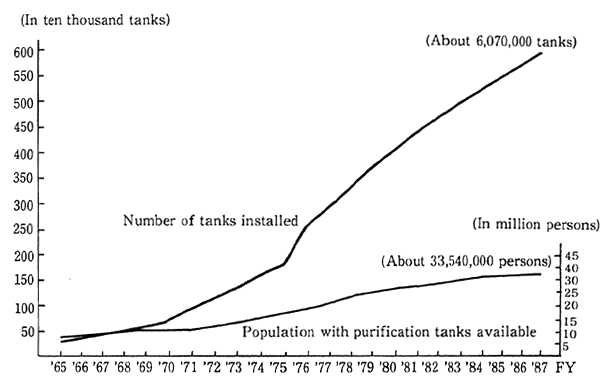
Remarks: Surveyed by the Ministry of Health and Welfare
Table 7-1-1 Treatment of human Waste
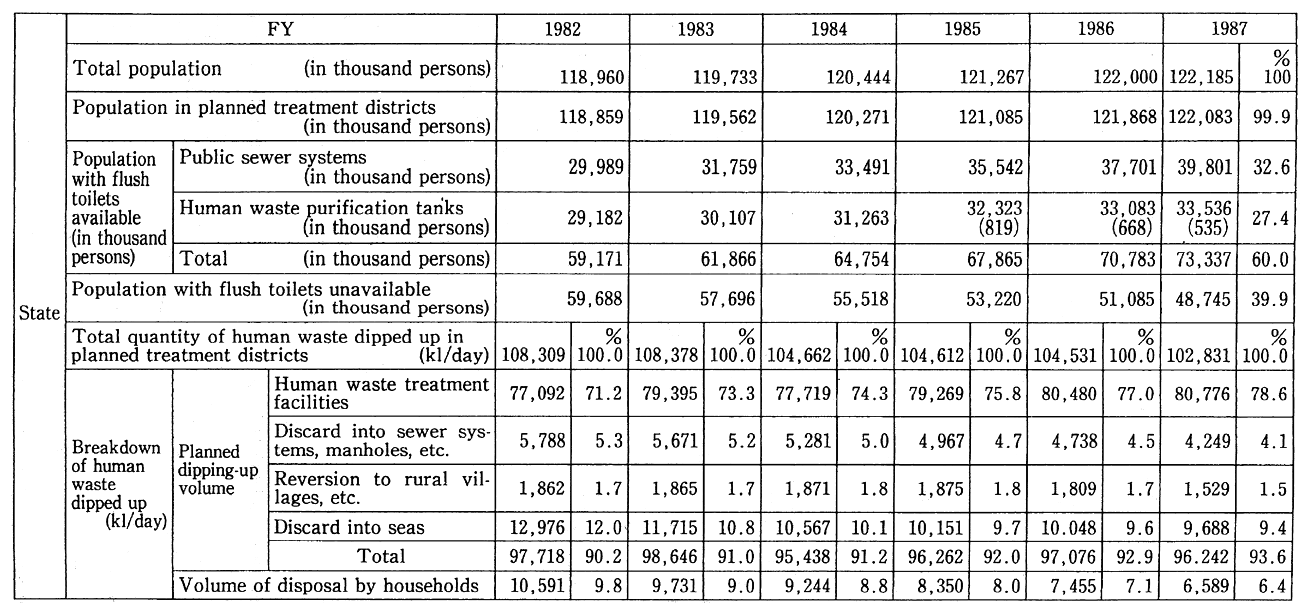
Remarks: 1. Surveyed by the Ministry of Health and Welfare.
2. Total volume of human waste dipped up = volume of human waste dipped up+volume of sludge in human waste purification tanks.
3. The figures in parentheses in the row for the population with human waste purification tanks available represent the population for whom community plants are available.
4. As fractions are cut away, the total figures do not coincide with the breakdown figures.
5. The total population includes the population of foreign residents in some municipalities.
Table 7-1-3 Treatment of Trash
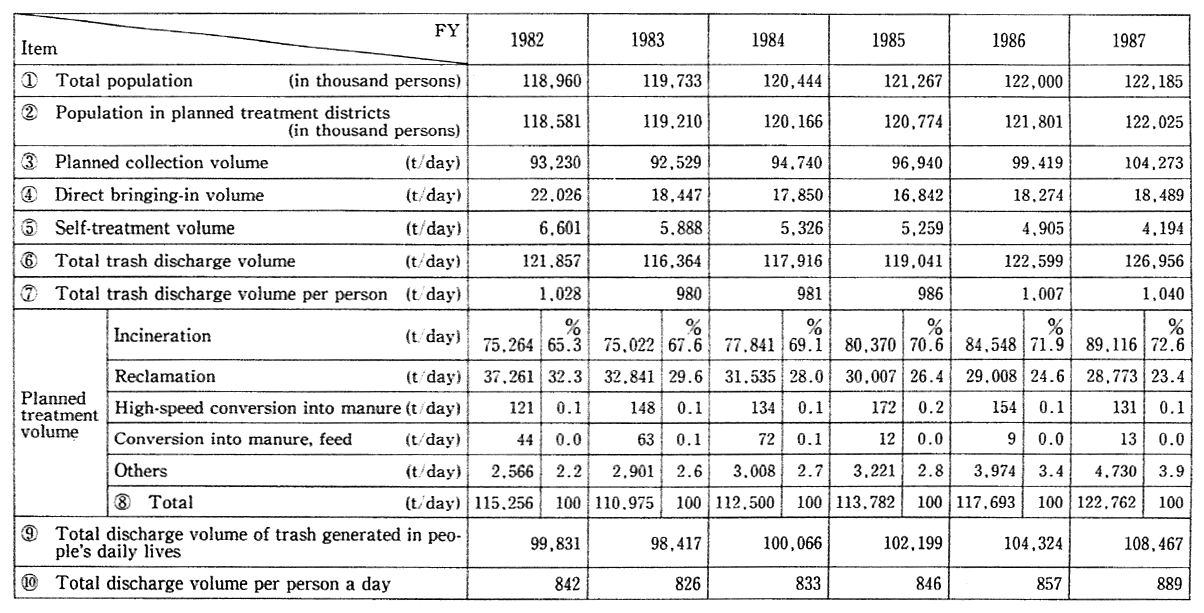
Remarks: 1. Surveyed by the Ministry of Health and Welfare.
2. (6) = (3) + (4) + (5),(7) = (6)/(2),(8) = (3) + (4),(9) = (3) + (5),(10) = (9)/(2)
3. As fractions are cut away, the total figures do not coincide with the breakdown figures.
4. The total population includes the population of foreign residents in some municipalities.
(2) Treatment of Industrial Waste
The treatment of industrial wastes is indicated in Table 7-1-4. The installation of industrial-waste treatment facilities as of April 1988 is shown in Table 7-1-5. The cases in which permission was granted for enterprises specialized in the treatment of industrial wastes increased year by year, coming to 62,489 cases as of April 1988.
The responsibility for the treatment of industrial waste rests with the entrepreneurs involved, in principle, but in recent years, the role played by enterprises specialized in the treatment of industrial waste has become increasingly important.
Table 7-1-4 Discharge of Industrial Waste (National)
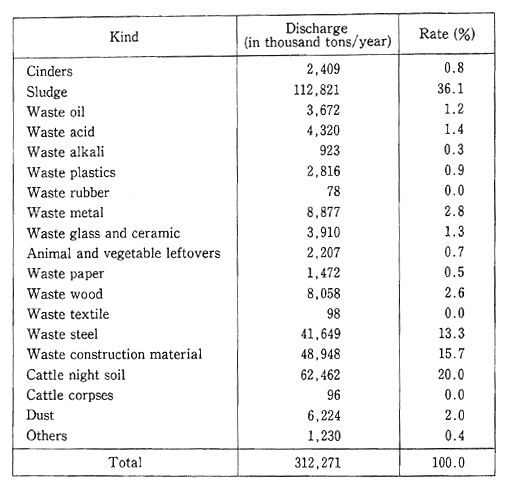
Remarks: Surveyed by the Ministry of Health and Welfare
Table 7-1-5 Installation of Industrial Waste Treatment Facilities
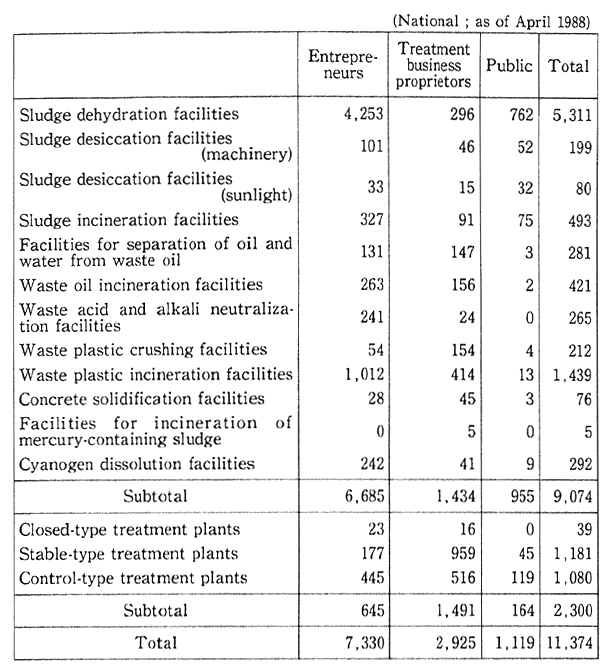
Remarks: 1. Surveyed by the Ministry of Health and Welfare.
2. The facilities are those. on which reports are filed under Article 15, Paragraph 1, of the Waste Treatment Law.
3. The final disposal plants where industrial and general wastes are put together for reclamation are included in the control-type treatment facilities.
4. "Public," referred to in the table, represents bodies corporate which are tied in with municipalities' tap water and sewer systems and industrial water projects.
2. Measures for Treatment of Waste
(1) General Waste
The development of facilities for the treatment of general waste is being systematically promoted under the Sixth Program for the Development of Waste Treatment Facilities, such with the development of new facilities and the rebuilding of many facilities whose renewal is just around the corner. The program is designed to promote the develop-ment of waste treatment facilities from fiscal 1986 to fiscal 1990 at a total project cost of ¥1,910 billion, out of which ¥1,429 billion is set aside for the development of general-waste treatment facilities.
For a project in which pipeline facilities for the transport of wastes will be developed and a project in which a new system for urban waste will be developed, ¥61.8 million and ¥182.7 million, respectively, are set aside.
The Ministry of Health and Welfare has carried out researches and surveys on the appropriate treatment of wastes.
The Ministry of International Trade and Industry began in fiscal 1987 under a four-year program to develop a new urban waste transport system designed to simultaneously realize highly efficient transport and the assurance of tap water in order to further assure the sound urban life and the conservation of the environment.
(2) Domestic Treatment Systems for All Household Wastewater
Much social attention is focused and high hopes are pinned on Gappei-Jokasou (domestic treatment systems for all household waste-water) as an effective means to treat domestic wastewater. In the system designed to subsidize grants-in-aid by municipalities to people who install Gappei-Jokasou, the amount of subsidies based on the national budget was increased to ¥2,060 million, and the number of municipalities which carried out this project increased from 221 in fiscal 1988 to about 500 in fiscal 1989.
In this project, incidentally, grants-in-aid from the National Coffer are advanced for the installation of Gappei-Jokasou, the improve-ment to Gapperi-Jokasou and the remodeling of large-scale Gappei-Jokasou. In regard to the amounts shared by local governments for the execution of this project, the Ministry of Home Affairs took necessary local financial measures in fiscal 1989.
(3) Industrial Waste
In respect of industrial waste, illegal dumping and other inappro-priate forms of disposal are still on the rise and are qualitatively diversified. First, in order to check environmental pollution by trichlor-oethylefle and tetorachloroethylene, standards for the final disposal of industrial wastes including those two chemicals and standards on the basis of which the disposal is commissioned to businesses engaged in the disposal were determined and put into force in October 1989.
The Ministry of Health and Welfare is making studies on the translation into action of a report formulated by experts on industrial wastes in the Waste Disposal Panel of the Living Environment Council in March 1988 on measures which would have to be implemented for the time being to cope with industrial waste. In regard to so-called medical waste discharged from medical institutions, the ministry has also released a Guideline for the Disposal of Medical Waste to provide guidance, as it was formulated by the Study Group on Measures for the Disposal of Medical Waste in November 1989. At the same time, it carries out a survey for studies on the appropriate treatment of indus-trial waste, including chemicals which are designated as hazardous matter.
In respect of administrative punishment and other actions in fiscal 1987, on-the-spot inspections were conducted in 55,927 cases, reports were collected in 10,868 cases, the licenses were canceled or temporarily suspended in 42 cases, and orders for actions or improve-ments were issued in 7 cases.
The Ministry of International Trade and Industry is carrying out tests, researches and surveys necessary for the disposal of industrial waste and recycling. The ministry has also subsidized a wide variety of recycling projects, such as the demonstration plant of the Clean Japan Center, and researches and surveys on dispersive waste and the exchange of wastes The recycling of waste from the manufacturing industries (including the electric power and gas industries) is shown in Table 7-1-6.
(4) Providing of Regional Waste Disposal Sites
In the major urban areas, the Ministry of Health and Welfare and the Ministry of Transport have worked for the promotion of the Projects for Regional Waste Reclamation Site (so-called Phoenix Pro-ject) in response to calls for the providing of regional waste disposal sites with each area counted as one unit. In the Osaka region, the construction by the Osaka Bay Regional Offshore Environment Improvement Center, etc., was promoted. The center began to accept the waste, reclamation and disposal, in part, in January 1990.
Table 7-1-6 Recycling of Industrial Waste (FY 1987)
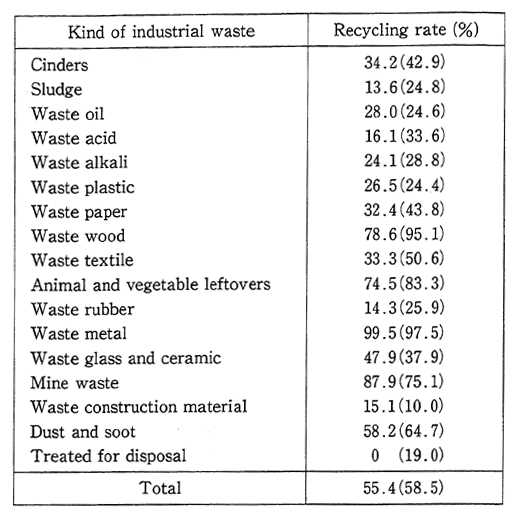
Remarks: Surveyed by the Ministry of International Trade and Industry. The figures in parentheses are those for FY 1998.
In regard to the Tokyo region, studies are under way on the regional disposal of wastes by the related local governments, and the Ministry of Health and Welfare and the Ministry of Transport have begun a survey for realization of the basic concept on the Tokyo Bay Phoenix Project which was presented to the related local governments in April 1987.
(5) Others
In order to prevent such environmental pollution as is caused by the sites from which facilities for the final and to work for their appropriate utilization, the Environment Agency and the Ministry of Health and Welfare served notice in their joint names on the direction of their control in November 1989, and the Environment Agency issued a manual on surveillance for a stabilization of facilities for the final disposal of wastes.
As measures to dispose of waste in ports and harbors, the Ministry of Transport subsidized the development of waste oil treat-ment facilities and carried out a project for the recovery of trash and oil in general sea areas in addition to subsidizing the development of sea walls for reclamation with wastes in 23 bays and one port with a project cost of ¥44.3 billion (including ¥11.9 billion from the National Coffer).
In response to the Basel Convention on the Control of Transboun-dary Movements of Hazardous Wastes and Their Disposal, the Environ-ment Agency carried out surveys on the hazardous wastes which are to be specified in the convention. The Environment Agency also prepared an interim report of Hazardous Waste Management by the Study Committee on Issues of Hazardous Waste Management and Basic Direction for Measures To Be Taken in July 1989.
Moreover, the Ministry of Construction worked for the utiliza-tion green farmland with sewer sludge, while taking account of the conservation of the environment, and for the development of resources, such as construction materials.
II. Ground Subsidence
1. Present State of Ground Subsidence
The history of ground subsidence is long. This phenomenon began to attract public attention since the early 1910s. (Fig. 7-2-1)
Fig. 7-2-1 Secular Changes in Ground Subsidence in Typical Areas
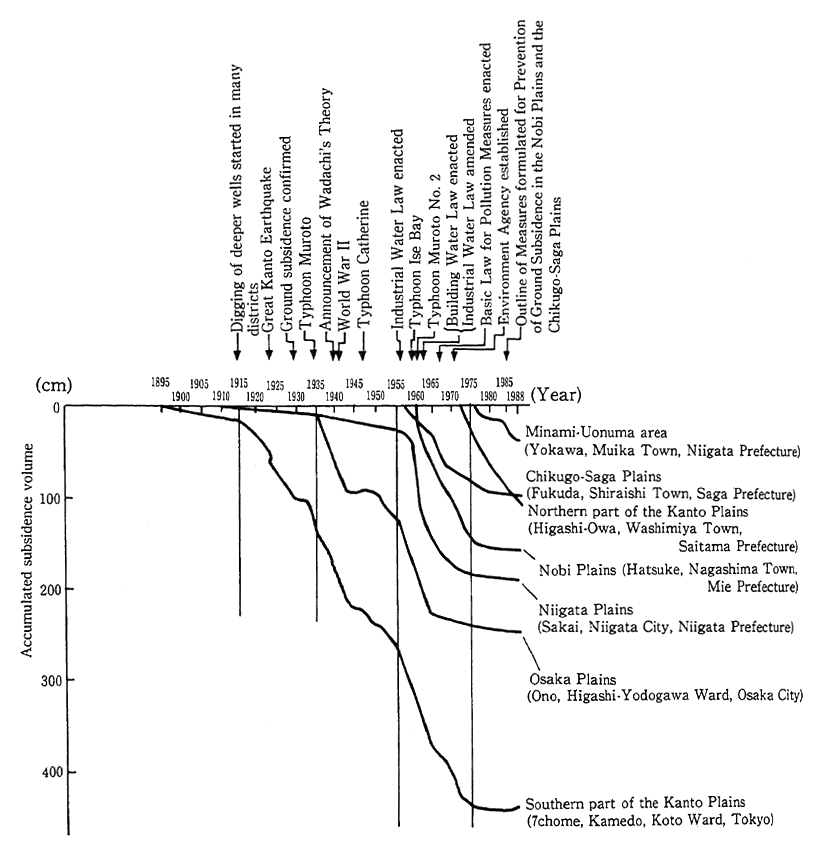
Ground subsidence is primarily caused by the excessive pumping up of groundwater. In fact, groundwater is pumped up not only for use in industry and buildings but for tap water, agriculture, aquaculture, snow melting and many other purposes. (Table 7-2-2)
Major areas in which ground subsidence had been observed before 1988 cover 61 areas in 36 prefectures. (Fig. 7-2-3)
The characteristics of recent ground subsidences throughout Japan are as follows:
(1) As for ground subsidence throughout Japan, the general level has stayed the same for the last several years but the area of ground subsidence has increased. In addition, marked subsidence still continue in some areas.
The area in which the most remarkable ground subsidence was seen in fiscal 1978 was the Chikugo-Saga Plain in Saga Prefecture and the northern part of Kanto Plain. In Chikugo-Saga Plain, the ground level has dropped by 5.6 cm in Saga Prefecture (Ariake-Cho), and in the northern part of Kanto Plain, the ground level has dropped by 5.4 cm in Saitama Prefecture (Kurihashi-Cho). In these areas, the ground level dropped by 3.7 cm and by 4.8 cm in 1987, respectively. Except the areas mentioned above, the areas where ground subsidence exceeded 4.0 cm per year were Koga City of Ibaraki Prefecture, the Kujukuri Plain of Chiba Prefecture, and Hachinohe City of Aomori Prefecture.
(2) In the past, marked ground subsidences wet observed in Tokyo' s wards, Osaka City and Nagoya City. As a result of the control on the pumping-up of groundwater enforced later, the progress of the phenome-non either slowed down or ceased. In other areas, there are signs of an improvement from a long-term perspective, but in the areas indicated in (1) above and some other areas, ground subsidences are still in progress.
(3) Such continuous ground subsidence has been causing damage to buildings, farmland and a number of facilities for water pumping, water control, harbors, and agricultural purposes in wide areas, threatening the hazard of disasters caused by floods, high tides, etc., in a number of sea-level areas.
Table 7-2-2 Use of Ground Water in Japan
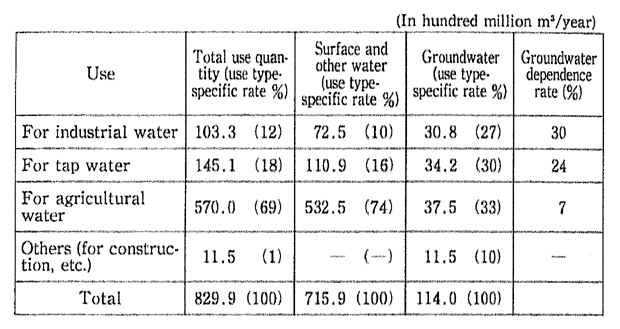
Remarks: 1. Computed on the basis of the Ministry of International Trade and Industry's "Table of Industrial Statistics" in 1987 (with the survey done in 1987 with the number of operation days projected at 300.
2. Computed on the basis of the Ministry of Health and Welfare's "Outline of Tap Water Statistics" in 1987 (with the survey done in 1987) (the total for the tap water system project and the water supply project).
3. The quantity of all water used for agriculture was computed on a trial basis, depending on the development of farmland. On groundwater for agricultural use, reference is made to the "Actual State of Ground-water for Agricultural Use" by the Ministry of Agriculture, Forestry and Fisheries in 1978 (with the survey done on the actual quantities in 1974).
4. "Others (for construction, etc.)" represents the quantity of ground-water which came to light according to he Fact-finding Survey on the Pumping of Groundwater, Etc." (FY 197188) done by the Environment Agency and th fact-finding surveys don by local governments.
Fig. 7-2-3 Areas prone to Ground Subsidence
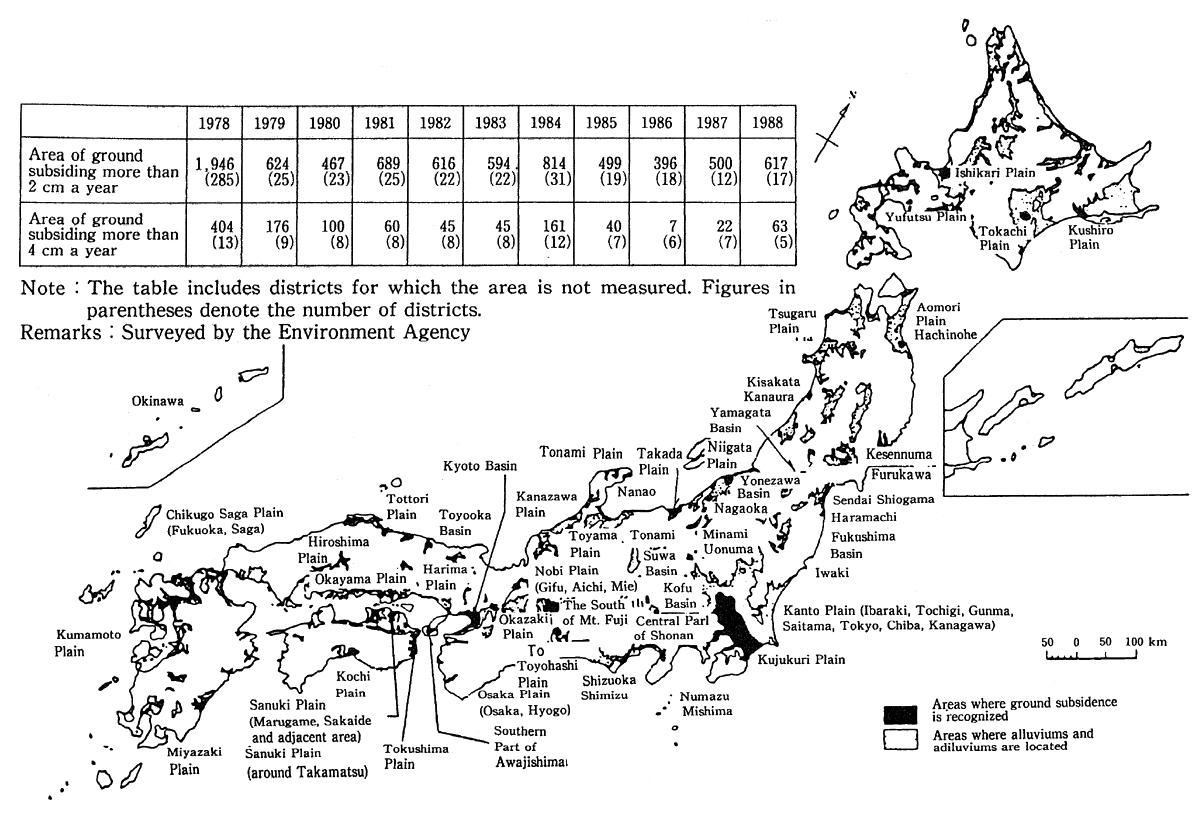
Area of Ground Subsidences Across the Nation (Tendency of Each Year)
2. Countermeasures for Ground Subsidence
In order to prevent ground subsidence, the pumping-up of ground-water is controlled under the Industrial Water Law and Law Concerning Regulation of Pumping-up of Groundwater for Use in Buildings, the so-called Building Water Law. At present, 10 prefectures and some areas of 4 prefectures are designated as such areas under the two laws, respectively. In many areas, besides the controls exercised under the ordinances of local governments, attempts are being made to reduce the pumping-up of groundwater with voluntary restriction on the pumping-up of groundwater for industrial use and administrative guidance for the rationalization of its use.
III. Soil Pollution--Present State of Pollution and Improvement Measures
1. Present State of Soil Pollution
In order to examine the present state of soil pollution of farmland with designated harmful substances, detailed surveys on farmland soil pollution has been carried out in areas with potential pollution. In fiscal 1988, surveys on cadmium were conducted in 11 areas out of 7 prefec-tures with a combined area of 771 hectares. No surveys were conducted on copper and arsenic.
It was found that two areas qualified for the areas where improvement measures were required (i. e. pollution levels exceeded the standard level). As a result, the total number of polluted areas increased to 128 with a combined area of 7,050 hectares.
2. Soil Pollution-Related Measures
(1) wThe Prevention and Removal of Farmland Soil Pollution
Of the areas where the pollution levels exceeded the standard levels, 39 areas with a combined area of 4,060 hectares designated as areas requiring improvement measures as of November 30, 1989 (exclud-ing the areas where improvement measures were completed and which are no longer designated). Measures are planned for 33 areas with a combined area of 2,780 hectares presently planned.
Table 7-3-1 Progress of Measures Against Farmland Soil Pollution
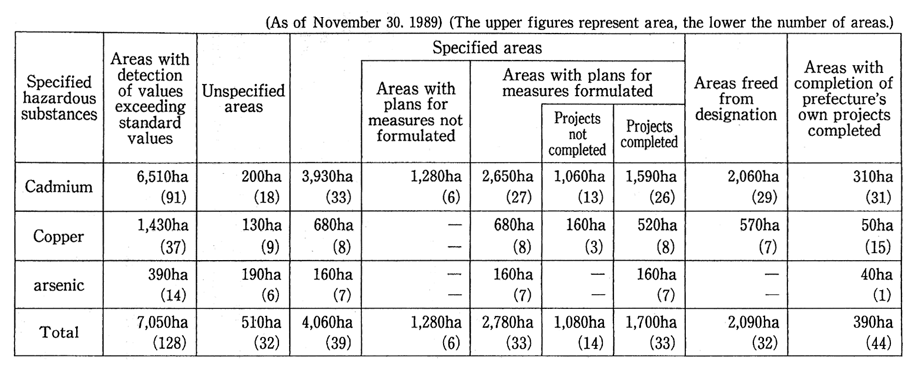
Remarks: 1. Surveyed by the Environment Agency
2. The "areas with detection of values exceeding standard values" are based on the findings of the elaborate surveys conducted before 1988.
3. Addition of the figures in each column for area and the number of areas does not coincide with those in the column for the totals, because pollution was overlapped. Addition of the numbers of areas in each row does not coincide with the totals and the numbers of "areas with detection of values exceeding standard values," because of the existence of areas separately designated and partially taken off.
4. "Projects completed in areas with plans for measures formulated" and "areas with completion of prefecture's own projects, etc." include the area of land turned to other uses.
5. "Projects completed in areas with plans for measures formulated" represent areas where surface construction in projects for measures with which the State is associated is completed.
In those areas which qualified for the measures, special land improvement projects for the prevention and removal of soil pollution, such as removal of polluted soil, clean soil dressing and replacement of water sources are under way. The total area where those projects are completed is 4,180 hectares (including those areas where projects are to be completed by the end of fiscal 1989), or 59.3% of the total area where the pollution levels exceeded the standard levels (Table 7-3-1).
In the areas where soils are polluted with cadmium, provisional measures to prevent the production of rice containing excessive cad-mium are taken until the improvement projects are completed.
In addition, a basic survey on soil environment is performed at fixed points in order to examine the overall state of farmland soil pollution by heavy metals.
In some areas where farmland soil is polluted, on-farm tests of the effects of improvement measures, such as top soil replacement and soil improvement are conducted.
Moreover, in light of the increasing utilization of recycled organic materials on the farmlands in recent years, efforts are being made to prevent excessive accumulation of heavy metals in farmland soils on the basis of provisional standards.
(2) Prevention and Removal of Soil Pollution in Urban Areas
In recent years, soil pollution cases by hazardous chemicals in urban areas have been found mainly from former sites of factories, testing and research institutions and other facilities. Given this situa-tion, a provisional guideline for improvement measures on state-owned tracts of land which are to be converted to public use (criteria for the assessment of polluted soil and guideline on improvement measures) were formulated in January 1986.
(3) Prevention of Pollution from Mining Sites
With respect to metal mining and other industries, measures are taken for the prevention of environmental pollution under the Mine Safety Law. Since there are not a few mine facilities of metal mining and other industries which may give rise to mining pollution even after their shutdown, efforts are being made for a systematic implementation of measures f or the prevention of mining pollution under the Law Concerning Special Measures for the Prevention of Mining Pollution in the Metal Mining and Other Industries.
IV .Pollution by Agricultural Chemicals--Present State and Measures
1. Present State of Pollution by Agricultural Chemicals
In conjunction with the increasing use of agricultural chemicals in the postwar years, the pollution of food and the environment by BHC, DDT, dieldrin and organic mercury agents, etc., came out as a serious social issue, but the kinds and output of such agricultural chemicals have conspicuously decreased since 1971 because the highly toxic and persistent agricultural chemicals were disused or their registration lost effect as a result of the strengthened controls on the use with a revision of the Agricultural Chemicals Regulation Law and the development of less toxic agricultural chemicals thanks to the advancement of science and technology. For this reason, environmental pollution of the sort which was caused by highly persistent agricultural chemicals occurs in few instances.
However, as the use of agricultural chemicals is essentially to discharge substances possessing bioactivity into the environment, there is a need to appropriately assess the safety of agricultural chemicals and control them so that they may not produce adverse effects on man's body and the environment.
2. Measures Against Pollution by Agricultural Chemicals
It is stipulated in the Agricultural Chemicals Regulation Law that agricultural chemicals for sale in Japan are required to be registered after passing tests on their toxicity and persistency in order to prevent pollution. Criteria on whether the registration should be rejected include (1) those associated with residues in crops, (2) those associated with residues in soil, (3) those associated with toxicity to aquatic fauna and flora, and (4) those associated with water pollution.
Of them, the criteria associated with residues in crops have been set on 229 agricultural chemicals as of the end of March 1989, and in respect of the other criteria, criteria common to each agricultural chemical have been set.
In situations where there is a danger that registered agricultural chemicals might harm men and livestock in the light of their persisten-cy, depending on how they are used, they are designated under the Cabinet Order as crop-persistent, soil-persistent or water-polluting pesticides and efforts are made to control their use.
Specified and other regulated agricultural chemicals are shown in Table 7-4-1.
From a perspective of the prevention of environmental pollution, surveys to cope with residual agricultural chemicals in crops, soil and water and fact-finding surveys on agricultural chemical persistency in the environment were conducted. In addition, studies for establishment of testing methods for confirmation of safety of agricultural chemical impurities and methods for assessment of impacts of agricultural chemi-cals on ecosystems and safety of microorganism agricultural chemicals, and researches and surveys on the dynamics of agricultural chemicals in the atmosphere, etc., were also performed.
Table 7-4-1 Agricultural Chemicals Banned in Terms of Environmental Pollution Prevention
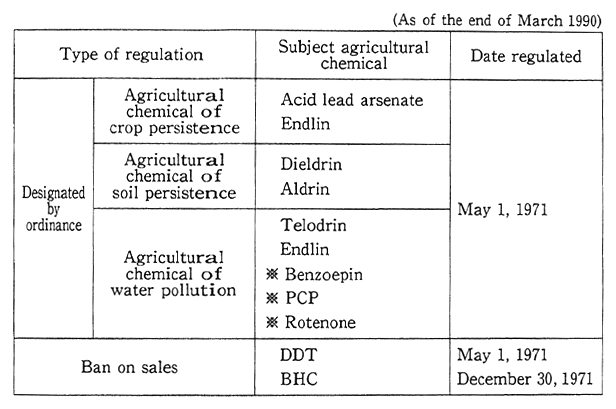
Remarks: 1. Surveyed by the Environment Agency
2. Agricultural chemical registered at present
Chapter8. Environmental Health Measures
I. Compensation and Prevention of Pollution-Related Health Damage
1. System of Compensation and Prevention of Pollution-Related Health Damage
In order to enhance the prompt and unbiased protection of the sufferers of pollution-related damage, the "Pollution-related Health Damage Compensation Law" was enacted on September 1, 1974. This law has played a major role in the protection of the sufferers.
Under this system, while taking civil liability into account, the sufferers are compensated at the expense of those who are responsible for the pollution. Designated diseases under this system are classified into the following 2 categories: One is composed of diseases, such as bronchial asthma, which do not have a specific relation with causative substances (the areas where the air pollution is significant and where the incidence of bronchial asthma and other diseases is high due to its impacts are designated as Class I areas), and the other is composed of diseases, such as Minamata Disease, Itai-Itai Disease and chronic arse-nic poisoning, which have a specific relation with causative substances (the areas where the environmental pollution is significant and where the incidence of the specific diseases is high due to its impacts are designated as Class II areas).
Of these 2 areas, the Class I areas were reviewed considering changes in the state of air pollution. The Central Council for Environ-mental Pollution Control submitted its report entitled "How Class I areas under the Pollution-Related Health Damage Compensation Law should be" in October 1986. Based on this report, the following amend-ments were made and have been enforced since March 1988, namely (1) the cancellation of the designation of Class I areas, (2) the continuation of compensation to those who are already certified as sufferers, (3) the implementation programs for the prevention of air pollution-related health damage and (4) the change of the name of the law to the "Law Concerning Compensation, Etc. for Health Damage by Environmental Pollution" (hereinafter referred to as the "Compensation Law").
Under the present state of air pollution, the amendments of the system, which are based on the scientific evaluation that it can no longer be regarded that air pollution is the main factor for asthma are still rational. The Environment Agency will further endeavor to protect certified patients and to implement the programs for the prevention of health damage.
2. Diseases by Air Pollution
(1) Compensation to Certified Sufferers
The number of certified sufferers as of the end of December 1989 was 102,650. As the designation of Class I areas was canceled on March 1, 1988, no new sufferers have been certified (Table 8-1-1). For the sufferers who have already been certified, the payment of the following benefits and allowances are continued as before under the Compensa-tion Law [(1) medical car benefits and medical care expenses, (2) compensation for disabilities, (3) compensation to bereaved families, (4) compensation to b reaved families (lump sum payment), (5) compensa-tory allowance to children, (6) medical care allowance and (7) funeral expenses]. The renewal of certification has also been conducted as before. In order to improve the health and welfare of the certified sufferers, the following projects are implemented: (1) rehabilitation projects, (2) projects for treatment by a change of air, (3) projects for supply of instrument necessary for treatment at home and (4) projects for guidance on treatment at home.
Eighty percent of the compensation fund comes from smoke-emitting facilities and the remaining 20% comes from automobiles.
In order to deal with requests for a review of the decision in regard to certification or the payment of compensation, there is the Pollution-Related Health Damage compensation Grievance Board. As for the Class I areas, there were 159 requests for review as of the end of December 1989, up to now, in 14 cases of which the decision was revoked, 11 cases were rejected and 90 dismissed by the council. In addition, 19 cases were withdrawn.
(2) Programs for Prevention of Health Damage
With the enforcement of the amended law in March 1988, pro-grams for the prevention of air pollution-related health damage (herein-after referred to as the "health damage prevention project") have been implemented . The project is designed to supplement and make more effective the measures thus far implemented by the State, local govern-ments for the prevention of air pollution-related health damage. The lines of business in this project include those directly conducted by the Pollution-Related Health Damage Compensation and Prevention Associ-ation (hereinafter referred to the "Association"), including (1) researches and surveys, (2) dissemination of knowledge and (3) training, and those conducted by local governments and the Japan Environment Corpora-tion with grants-in-aid from the Association, including (1) the formula-tion of programs, (2) consultation and advice on health, (3) medical examinations, (4) functional training, (5) the development of facilities useful for the prevention of health damage, and (6) grants-in-aid for the development of facilities, etc (Fig. 8-1-2).
Table 8-1-1 Designated Areas, Number of Certified People, Etc., under the "Law Concerning Compensation for Pollution-related Health Damage and Other Measures".
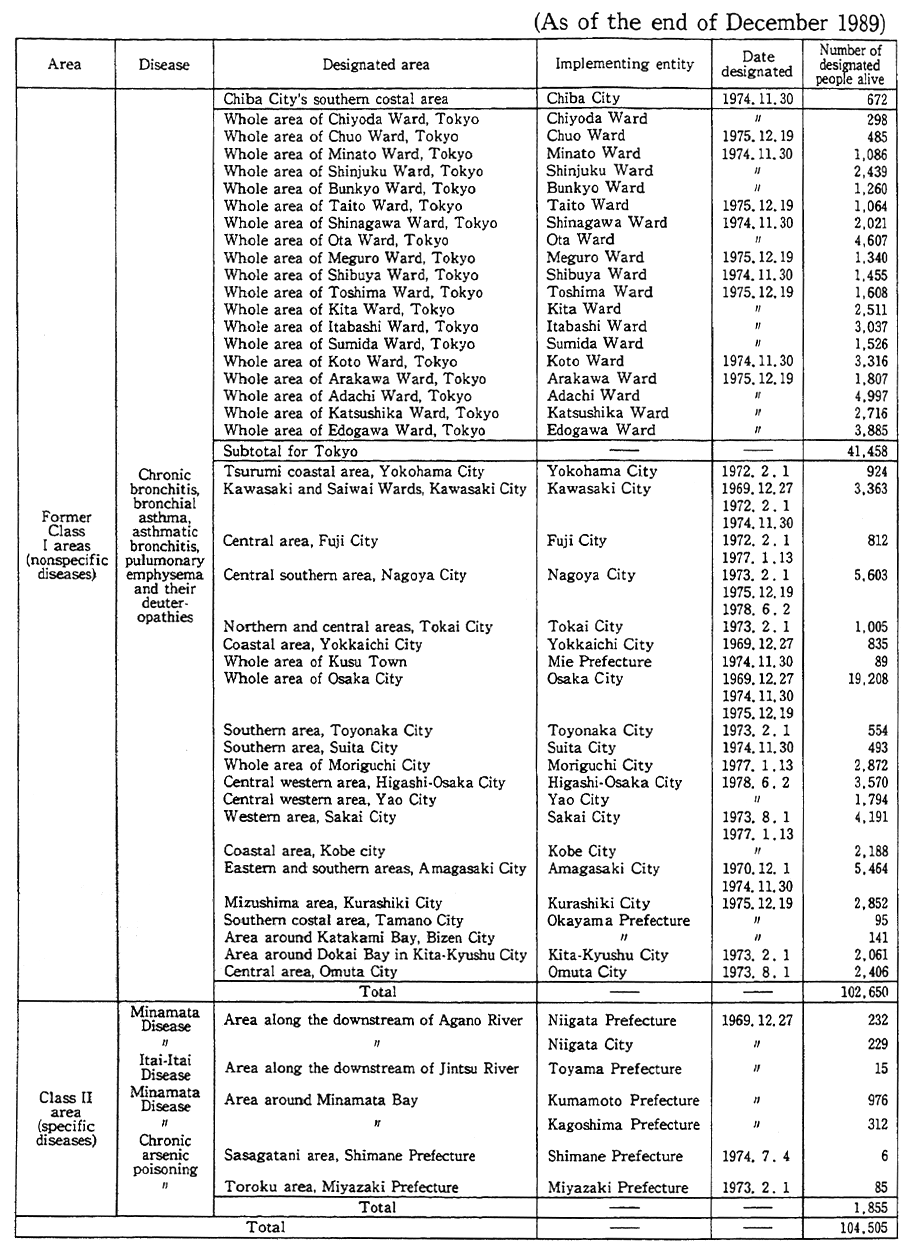
Remarks:1. Surveyed by the Environment Agency.
2. The indication of designated areas are all according to the administra-tive demarcation in force at the time of designation.
The Association's financial source is covered by the profit ac-crued from the operation of its fund. The total amount of the fund is set at ¥50 billion. The fund will be met by contributions from those who are directly responsible for air pollution and those whose business perfor-mance is associated with air pollution as well as appropriation from the State (¥279 million in fiscal 1989) over a period of seven to eight years, while the fund for projects in each fiscal year is covered by these contributions.
The implementation of health damage prevention projects in fiscal 1989 is as follows:
a. Projects Directly Done by the Association
The researches and surveys done by the Association include surveys on bronchial asthma, etc. in major cities, and researches and surveys of which will contribute to improvements in the atmospheric environment. For the spread of knowledge, campaigns, such as less-polluting car fairs and events in the Month for Promotion of Air Pollution Prevention, and pamphlets were prepared for the prevention of asthma, etc. and recovery from them ; and persons engaged in the health damage prevention projects were trained.
b. Payment of Grants-in-Aid by the Association
Grants-in-aid were given to 49 local governments and the Environ-mental Pollution Control Service Corporation, and in Class I and other areas where projects were to be conducted, the formulation of programs for improvements in the atmospheric environment; health consultations on asthma, etc.; medical examinations to babies and infants; functional training, such as at asthma curing camps; introduction of electric and other less-polluting cars; afforestation for air purification; and develop-ment of green zones against air pollution, etc., were implemented.
Fig. 8-1-2 Outline of Health Damage Prevention Projects
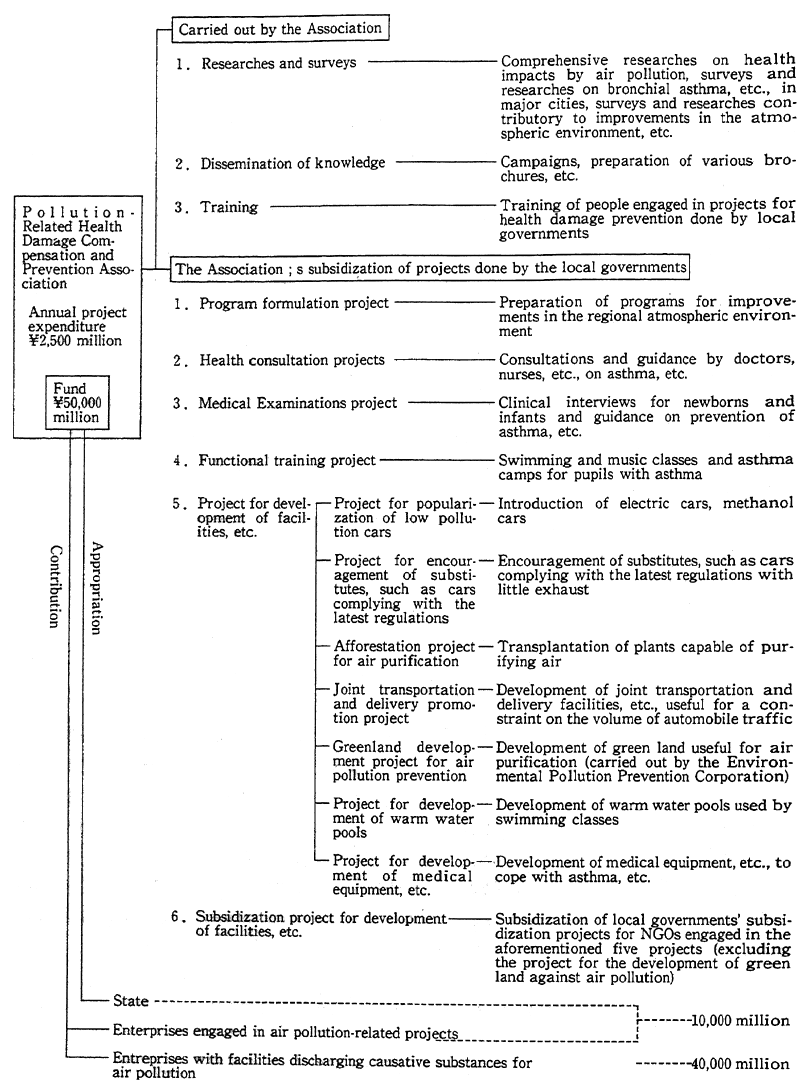
3. Minamata Disease
(1) Historical Developments
Minamata Disease was detected in areas along Minamata Bay in Kumamoto Prefecture in May 1956 and in the basin of the Agano River in Niigata Prefecture as the Second Minamata Disease. In September 1968, the government established a uniform view that the disease was caused by the oral intake of fish and shellfish in which methylmercury was accumulated as it had been discharged by Chisso Corporation and Showa Denko K. K., respectively.
At the time of the outbreak of the diseases, Kumamoto Prefec-ture, Niigata Prefecture and others took their own measures to cope with Minamata Disease, but with the enactment of the Law Concerning Special Measures for Relief of Pollution-Related Health Damage (here-inafter referred to as the "Relief Law") in December 1969, the areas related to the disease were specified as the designated areas. In August 1971, official notices were issued by the Administrative Vice Minister of the Environment Agency and the Director of the Pollution and Health Division on the criteria for the certification of Minamata Disease, so that the certification process could be administered in full accord with the basis of medical science under the Relief Law.
On the other hand, the judgment of the first suit on Minamata Disease in Niigata was handed down in September 1971 and that of the first suit on Minamata Disease (Kumamoto) in March 1973. In these judgments, the obligation of Showa Denko and Chisso to compensate for damages were recognized by the court. Based on these judgments, agreements on compensation were concluded between sufferers' organi-zations and Showa Denko in June 1973 and between them and Chisso in July 1973. Thereafter the sufferers certified under the Relief Law or the Compensation Law have been able to receive compensation directly from these companies.
Under the Compensation Law which had superseded the Relief Law in September 1974, the areas were designated and administrative work for certification, such as criteria for certification, was also carried on.
In the case of Minamata Disease in Kumamoto Prefecture, the number of those who applied for certification as sufferers increased drastically and therefore the number of those left unjudged increased. Under such circumstances, the Cabinet members related to Minamata Disease reached an agreement on the "Promotion of Minamata Disease Measures" at the meeting held about this problem in June 1977, and it was decided that the certification process of the disease should be spend up.
In response to this agreement, a notice "On Criteria for Differen-tiation of Acquired Minamata Disease" was issued in July 1977 in the name of the Director of the Environmental Health Department and the notice clarified concrete criteria for the diagnosis of Minamata Disease for certification. In July 1978, a notice was also issued "On the Promo-tion of Administrative Work for Certification of Minamata Disease" in the name of the Administrative Vice Minister of the Environment Agency.
In Kumamoto Prefecture, too, efforts were made for the quick reduction of the number of applicants who had yet to be judged about certification, such as by the establishment of a system for the medical examination of 150 people and the judgment of 120 people a month in October 1977 (in August 1986 this system was shifted to a new one for the medical examination of 250 people and the judgment of 200 people). In February 1979, furthermore, the Law Concerning Provisional Mea-sures for the Promotion of Administrative Work on Certification of Minamata Disease was enacted, thus enabling the State, too, to do administrative work.
(2) Present Situation
a. Certification of Minamata Disease
The number of those certified as sufferers of Minamata Disease in areas along Minamata Bay was 976 as of the end of December 1989 [the total number of certified sufferers under the Relief Law or the Compensation Law was 1,714, and there were 44 other people who had been certified before the enactment of the Relief Law (including those who had not been certified because of their death before the enactment of the Relief Law)], 312 people in Kagoshima Prefecture (the total number of certified sufferers under the Compensation Law or the Relief Law was 467, and there was one person certified before the enactment of the Relief Law (Table 8-1-1), and the number of those who were waiting for certification was 3,053 people in Kumamoto Prefecture and 455 people in Kagoshima Prefecture.
In the last two or three years, the pending applicants have proceeded relatively smooth handling and the number has gradually decreased since 1986, but there still are many people who are waiting for certification, because a considerable number of applications (including re-applications) continue to flood in, some applicants refuse to undergo a medical examination, it becomes difficult to make judgment due to the aging of applicants, and an increasing number of people who died before a medical examination or are unable to undergo them as they are bedridden, etc.
On the other hand, the number of people certified as sufferers of Minamata Disease in the basin of the Agano River (Niigata Minamata Disease) was 461 as of the end of 1989 (the total number of certified sufferers under the Relief Law or the Compensation Law was 685, and there are 5 other people certified before the enactment of the Relief Law), and the number of applicants who are left unjudged was 15.
For this reason, it is necessary to speed up administrative work on certification for the prompt reduction of the numbers of pending applications in Kumamoto and Kagoshima Prefecture, and it is impor-tant to appropriately maintain and operate the medical examination and judgment system for which development and expansion efforts have been made, and to strengthen measures for people whose medical examination and judgment are delayed, such as those living outside the prefectures. For applicants outside the prefectures, medical examina-tion institutions have been steadily developed in Nagoya, Osaka and Tokyo.
Certification on Minamata Disease has been made on the basis of medical judgments, and a meeting of medical specialists on Minamata Disease was held in October 1985 to reassure its validity.
b. Medical Treatment Research Project and Special Medical Care Program
The Medical Treatment Research Program, which was designed to subsidize the share in the medical-care cost, etc., paid by applicants whose examination and judgment drags on over a long time for certifi-cation, began in fiscal 1974, thereby observing and grasping the changes in their systems, whereas the Special Medical Care Program, which was designed to subsidize the share in the medical-care cost paid by people whose applications had been dismissed but who were found to have met certain conditions, started in June 1986. The latter is a medical-care research program which is designed from a "social relief perspective" to contribute to an identification of the causative factors and work for an abatement of the sense of uneasiness they have about their health, by extending administrative support for the treatment of persons who are found not to be suffering from Minamata Disease but have certain neurological symptoms the causative factors of which cannot be identified.
c. Requests for Reviews of Administrative Dismissal of Applications for Certification of Minainata Disease
As of the end of December 1989, there were 625 cases in which requests for reviews of the administrative dismissal under the Relief Law had been filed with the Director-General of the Environment Agency. Up to now, in 12 cases, the administrative dismissal was revoked, 2 cases were rejected and 345 cases were dismissed, and 35 cases were withdrawn. As of the end of December 1989, there were 622 cases in which the review of the administrative disposition under the Compensation Law, had been filed with the Pollution-Related Health Damage Compensation Grievance Board. Up to now, 4 cases the admin-istrative dismissal were revoked, 2 were rejected and 195 dismissed, and 59 cases withdrawn.
d. Minamata Disease-Related Lawsuits
At present, the suits brought by groups of applicants for certifica-tion of Minamata Disease with the State and prefectures as defendants are pending in 8 courts in Japan in respect to the outbreak and spread of Minamata Disease and the relief of sufferers.
e. Financial Support to Chisso
To the people who are certified as the sufferers of Minamata Disease, Chisso Co., the polluter, has directly compensated for their health damage. Adhering to the Polluter Pays Principle, giving consider-ation to the necessity to ensure the continuation of the compensation, and from the viewpoint of stabilizing the regional economy and society, the government has requested related banking institutions for financial and other support in accordance with the agreement the Cabinet rea-ched in June 1978 "On Measures to Cope With Minamata Disease," on the one hand, and a system is in effect whereby the funds procured by Kumamoto Prefecture with the bond may be put on loan to Chisso Corporation, on the other.
This system was such that the deadline came with the payment of compensation in fiscal 1987, but after consultations among related ministries and agencies, it was decided in respect of handling in fiscal 1988 and subsequent years that this system would be continued in force for yet another three years till the payment of compensation for fiscal 1990. In this conjunction, necessary decisions were made on policy in fiscal 1988 and subsequent years by the Council of Ministers Related to Minamata Disease when it was convened in December 1987.
f. The National Institute for Minamata Disease
The National Institute for Minamata Disease, established in October 1978 as the nation's sole comprehensive medical research insti-tution on Minamata Disease, is engaged in clinical researches, basic researches and epidemiological surveys and researches for a clarifica-tion of the clinical manifestation of Minamata Disease and the establish-ment of therapeutic methodologies, among others In September 1986, this Institute was designated as a collaborative study center by the World Health Organization (WHO). The Institute consists of I division, 3 departments and 11 staff rooms with a staff of 28 persons.
4. Itai-Itai Disease
(1) Historical Developments
Itai-Itai Disease, which had occurred in the basin of the Jintsu River in Toyama Prefecture, was reported in October 1955 to a medical society as a strange disease the pathogensis of which was unknown. In May 1968, the Ministry of Health and Welfare expressed the administra-tive view that chronic cadmium poisoning gave rise to renal disorders and further to osteomalacia, adding to them pregnancy, breast-feeding, endocrinopathy, aging and malnutrition especially a shortage of cal-cium, served as a drive to Itai-Itai Disease, and that no other causative factor had been detected other than waste water from the Kamioka Mining and Smelting Plant of Mitsui Mining and Smelting Co.
With the enactment of the Relief Law in December 1969, the basin of the Jintsu River became a designated area and was designated as a Class II area under the Compensation Law which had superseded the Relief Law in September 1974.
(2) Present Situation
As of the end of December 1989, 15 people were certified (the total number of certified sufferers under the Relief Law or the Compensation Law was 128). In Toyama Prefecture, the health examination of 12 people requiring observation in its designated areas was conducted to check the course.
There were 7 cases in which requests for a review of the adminis-trative decision under the Compensation Law had been filed with the Pollution-Related Health Damage Compensation Grievance Board as of the end of December 1989.
5. Chronic Arsenic Poisoning
(1) Historical Developments
As for chronic arsenic poisoning in the Toroku area of Miyazaki Prefecture, it was reported in July 1972 on the basis of a survey by Miyazaki Prefecture that there were people who could be considered as the patients of chronic arsenic poisoning, and it was designated as an afflicted area under the Relief Law in February 1973.
As for chronic arsenic poisoning in the Sasagatani area of Shimane Prefecture, it was reported in August 1973 that there were people who could be considered as the patients of chronic arsenic poisoning, and it was designated as an afflicted area in July 1974.
Later, both areas were designated as Class II areas under the Compensation Law which had superseded the Relief Law in September 1974.
(2) Present Situation
The number of certified sufferers as of the end of December 1989 was 85 in the Toroku area (the total number of certified sufferers under the Relief Law or the Compensation Law was 140) and 6 in the Sasagawa area (the total number of certified sufferers under the Relief Law or the Compensation Law was 21).
There were 67 cases in which requests for a review of the administrative decision under the Compensation Law had been filed with the Pollution-Related Health Damage Compensation Grievance Board as of the end of December 1989, Up to now, in 5 cases, the administrative decision has been revoked, 38 cases have been dismissed and 12 have been withdrawn.
II. Surveys and Researches on Environmental Health
1. Surveys and Researches on Health Impacts by Air Pollution
In order to periodically and continuously monitor relations between air pollution and impacts on health and promptly build an environmental health surveillance system for the formulation of neces-sary measures, the Environment Agency has conducted surveys for the establishment of methodologies.
For an assessment of relations between localized air pollution and impacts on health as is the case with roadside areas along some trunk roads, the agency has also performed surveys for the establish-ment of surveying methodologies.
2. Surveys and Researches on Health Effects by Cadmium, Etc.
As the Ministry of Health and Welfare identified cadmium as the primary cause for Itai-ltai Disease in 1968, the health examination of residents in cadmium-polluted areas have been conducted to prevent cadmium from producing damage on their health. In the health examina-tion, no patients with Itai-Itai Disease have been found in areas other than the basin of the Jintsu River in Toyama Prefecture. The Environ-ment Agency has continued a health examination in the basin of the Joetsu River since fiscal 1985 on persons whose medical findings were detected in the proceeding health examination.
Since there exist controversies on a cause of Itai-Itai Disease and the health effect of cadmium, especially the cause-effect relationship between cadmium exposure and renal tubulopathy, the Environment Agency stepped up:
[1] An experiment of the health effects of cadmium on large animals (monkeys) with the long-term small dose of cadmium,
[2] A clinical study both on the significance of symptoms, such as low-molecular weight proteinuria detected among residents in cadmium-polluted areas, and their pathogensis.
[3] A study for the improvement of prognosis for persons certified as suffering from Itai-Itai Disease and its prevention, and
[4] A pathological study for autopsies and biopsies. The findings of those studies and an experiment was compiled and released in an interim report. As it was concluded in the report that it was necessary to continue further surveys and researches on the effects of cadmium on kidneys and bones, those studies are continued to make clear the health effects of cadmium.
In order to promote scientific surveys and researches on the impacts of water and other pollution on human bodies, the Environment Agency is making comprehensive studies on Minamata Disease and all-inclusive researches on the impacts of heavy metals on human bodies.
Chapter9. Settlement Of Environmental Pollution Disputes And Control Of Environmental Pollution Offenses
I. Environmental Pollution Disputes and Grievances about Environmental Pollution
1. Environmental Pollution Disputes
It is stipulated in the Law Concerning the Settlement of Environ-mental Pollution Disputes that disputes over environmental pollution shall be settled by the Environmental Disputes Coordination Commis-sion established as an external organ of the Prime Minister's Office and Prefectural Environmental Disputes Coordination Commissions. (Fig. 9-1-1).
Fig. 9-1-1 Scheme of Pollution Dispute Processing System
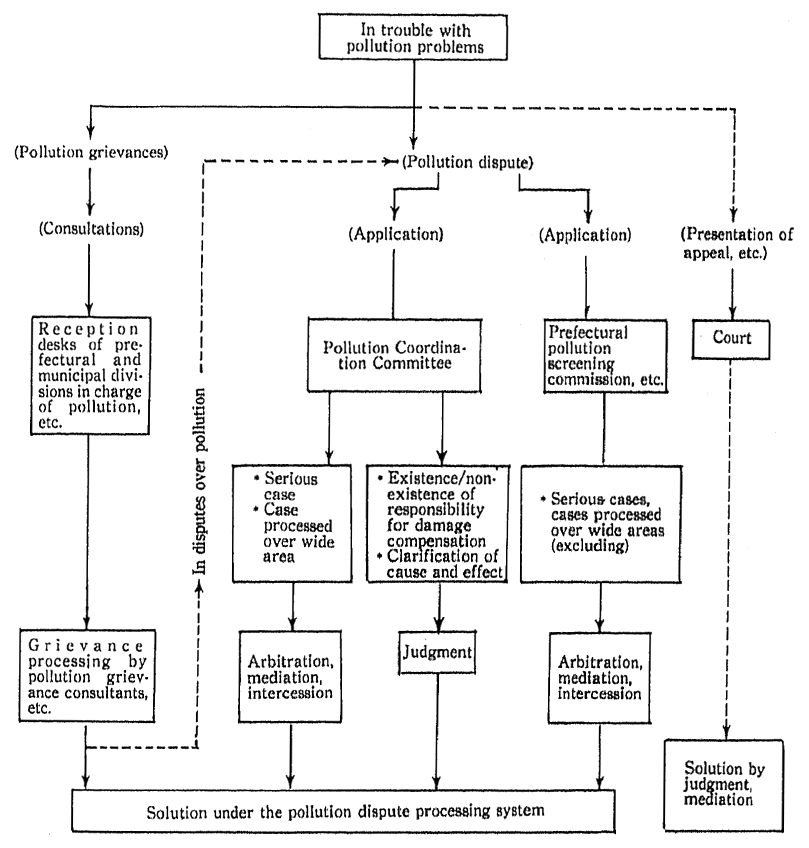
The Environmental Disputes Coordination Commission passes rulings and makes mediation, arbitration and intercession on specific disputes (so-called grave incidents and incidents requiring inter-prefectural disposition, etc.), whereas Prefectural Environmental Dis-putes Coordination Commissions make mediation, arbitration and inter-cession on other disputes.
The rulings fall under two categories-rulings on liabilities in which rulings will be made on whether liabilities for compensation for damage done in association with environmental pollution and on the amounts of damages, and rulings on causative factors in which rulings will be passed on cause and effect between damage and conduct by assailants.
(1)Cases Dealt with by the Environmental Disputes Coordination Commission
In 1989, the Environmental Disputes Coordination Commission dealt with 23 cases (including 19 arbitrated cases, 2 cases with liberal-ity rulings, 1 case with rulings on causative factors and one other case). The breakdown follows:
a. Arbitrated Cases for Applications
(a) The compensation damage done by Minamata Disease in areas along the Sea of Shiranui --- 15
(b) The compensation for damage on cultured sea weeds in the Bay of Sendai --- 1
(c) Damage, etc. caused by the noise of Shinkansen super-express trains --- 1
(d) A ban on the use of studded tires, etc --- 2
b. Cases with Rulings on Liability
Liabilities for damage, etc. cause the noise of roads --- 2
c. Case with Rulings on Causative Factors
Causative Factors for Damage Produced on Cultured Pearls in Iki --- 1
d. Other case
Request for Recommendation on the fulfillment of obligations by the Osaka International Airport --- 1
Of all those cases 10 new applications were filed in 1989, and there were 13 applications which had been carried over from 1988. The new applications included 8 on Minamata Disease in a-(a), above, and 2 on a ban on the use of studded tires in d.
The concluded cases included 12 cases on Minamata Disease in a-(a), 1 case on damage produced on sea weeds in (b), 1 case on damage produced by the noise of Shinkansen super-express trains, in (c), 2 cases on a ban on the use of studded tires in (d) 2 cases for rulings on liability for damages for the noise of roads in b, and 1 case for rulings on causative factors for damage on cultured pearls in c.
(2) Cases Dealt With by Prefectural Environmental Disputes Coordination Commissions
In 1989, 25 applications for arbitration on environment pollution disputes were accepted by prefectural environmental disputes coordina-tion commissions (including 24 cases for arbitration and one case for mediation).
In 1988, 27 cases were concluded (including 15 on which arbitra-tion was concluded, 9 cases which were canceled and 3 cases which were withdrawn).
2. Grievances about Environmental Pollution
(1) System of Consultations on Grievances About Environmental Pollution
Grievances about environmental pollution are closely tied in with the lives of local residents, and it is extremely important to appropriate-ly deal with them for the conservation of their living environment and for the prevention of disputes over environmental pollution in the future.
From this standpoint, it is stipulated in the Law Concerning the Settlement of Environmental Pollution Disputes that local governments shall appropriately deal with grievances about environmental pollution with the cooperation of related administrative institutions. For this, it is stipulated that prefectures and municipalities may designate consultants on grievances about environmental pollution.
The Environmental Disputes Coordfination Commission provides guidance and information so that local governments may be able to appropriately deal with grievances about environmental pollution.
(2) Present Situation and Settlement of Grievances About Environmental Pollution
In fiscal 1988, local governments across the country received 72, 565 grievances about environmental pollution, up 3,252 cases or 4.7% from the previous fiscal year.
A type-specific classification of damage by 7 typical types of environment pollution indicates that sensory and psychological damage was greatest with 42,498 cases (83.0% of the grievances about the 7 typical kinds of environmental pollution), which was followed by dam-age on property with 2,593 cases (5.1%) and damage on health with 1,545 cases (5.0%).(Fig. 9-1-2).
In fiscal 1988, 81,571 cases which had been either carried over from the previous fiscal year or transferred from other institutions remained pending in addition to newly accepted cases. Of them, 70,434 cases were dealt with in fiscal 1988.
II. Environmental Pollution Offenses
Police are stepping up the response to offenses with emphasis put on offenses of maliciously disposal of industrial wastes and those of water pollution. In 1989, arrests were made in 2,075 cases with offenses on environmental pollution. Trends in the number of arrests associated with offenses on environmental pollution in the last 5 years are indicat-ed in Table 9-2-1.
The arrests made in 1989 are tabulated in Table 9-2-2 by type of law. Violations of the Waste Disposal and Public Cleansing Law account for 97.3% of all arrests.
Fig. 9-1-2 Trends in Component Ratio of Damage by Kind
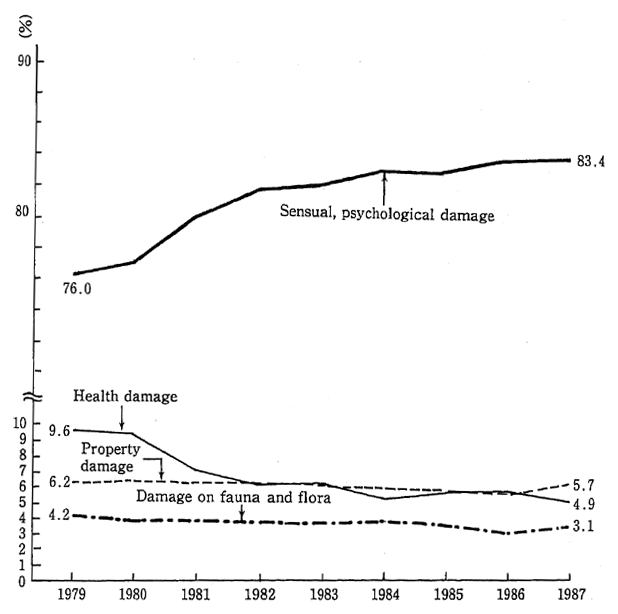
Remarks: Pollution Coordination Commission, "Report on Results of Survey on Number of Pollution Grievances"
Table 9-2-1 Trends in Number of Arrests in Pollution Offenses
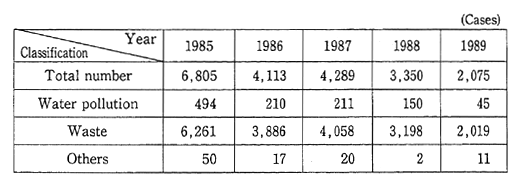
Remarks: Surveyed by the National Police Agency.
Table 9-2-2 Number of Arrests in Pollution Offense by Law

Remarks: Surveyed by the National Police Agency.
Chapter10. Conservation Of Natural Environment
In many parts of Japan, which is blessed with varied land form and rich green, picturesque scenery and wild fauna and flora may be observed. it is necessary to systematically promote the conservation of the natural environment, depending on the quality of nature, such as primeval nature and picturesque scenic spots; on secondary nature including rural areas; and on nature in urban areas. Appropriate approaches are required, as the people have a mounting desire to use nature as places for outdoor recreation, tourism, rest and education on nature.
I. Comprehensive Promotion of Measures for Conservation of Natural Environment
1. Basic Survey on Conservation of Natural Environment
Let alone vegetation which encloses the national land, the natural environment including rivers, lakes, reservoirs, seacoasts and sea areas are strikingly changing at all times along with inhabiting wild animals. In order to appropriately conserve the natural environment, therefore, it is necessary to come to accurate grips with the present state of the natural environment and ascertain the direction in which they are changing.
Given this necessity, a basic survey on the conservation of the natural environment is performed in accordance with Article 5 of the Natural Environment Conservation Law. This survey is conducted almost every 5 years to comprehensively and scientifically grasp the state of the nation's natural environment, and it is generally known as the Green Census. Following the first survey in fiscal 1973, the second in fiscal 1978-79 and the third in fiscal 1987, the Fourth Basic Survey on the Conservation of the Natural Environment was started in fiscal 1988 (Fig. 10-1-1).
In fiscal 1989, the findings of a survey on huge trees and forests of huge trees conducted in fiscal 1988 were nationally tabulated. At the same time, (1) a survey on vegetation with the utilization of satellite pictures, (2) a survey on the distribution of fauna and flora (a survey on things inhabiting nearby) with the participation of volunteers from the masses, and (3) a survey on the biological environment of sea areas to grasp the present state of places with algae, beaches at ebb tide and coral reefs were conducted.
Fig. 10-1-1 Keynotes of the 4 th National Survey on Preservation of Natural Environment
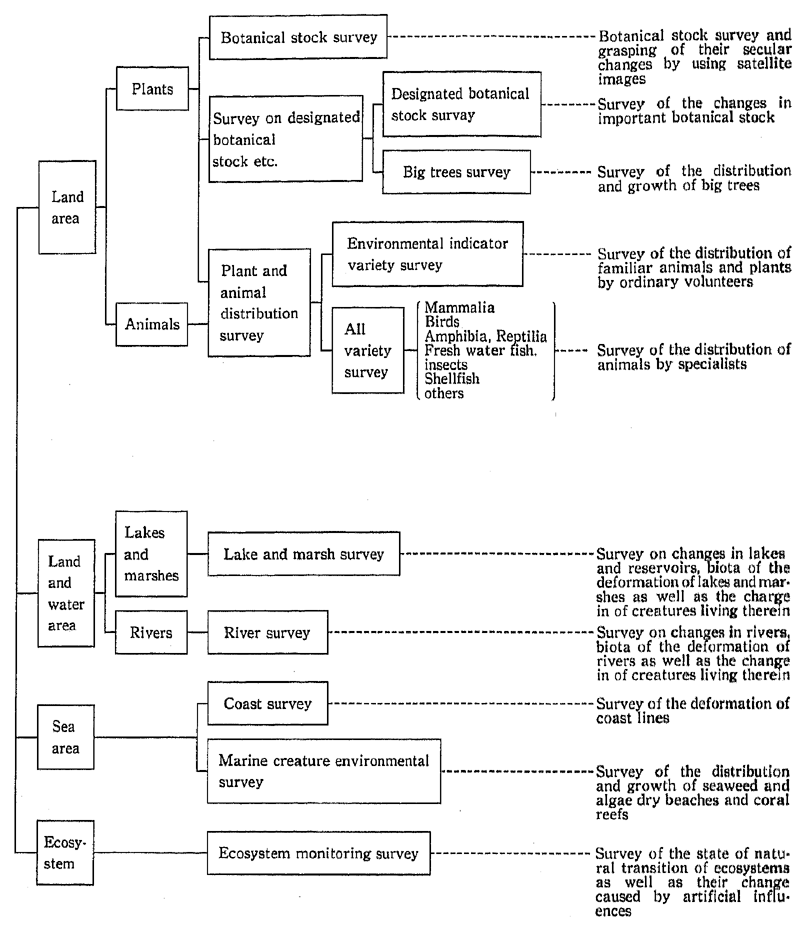
2. Designation of Areas for Conservation of Natural Environment
In order to work for conservation of th natural environment, it is stipulated in the Natural Environment Conservation Law that the State shall designate "areas for conservation of the primeval natural environment" (areas where the primeval state of the natural environ-ment is preserved without being affected by man's activity) and "areas for conservation of the natural environment" (areas other than the areas for conservation of th primeval natural environment, where it is deemed particularly necessary to conserve the natural environment in light of their natural and social situations).
As of the end of fiscal 1989, 5 areas for conservation of the primeval natural environment and 9 areas for conservation of the natural environment were designated (Table 10-1-2).
It is also stipulated that prefectures may be able to designate as "prefectural areas for conservation of the natural environment" those areas where it is deemed particularly necessary to conserve the given natural environment in light of their Peripheral natural and social situations, and 507 areas ,were designated such as of the end of fiscal 1989 (Table 10-1-2).
Table 10-1-2 Classified Areas in Natural Conservation Areas etc.
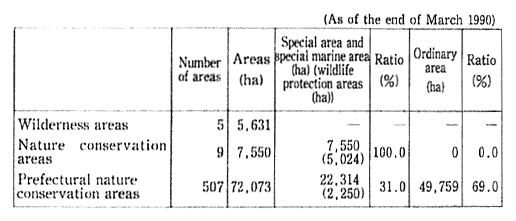
Remarks: Surveyed by the Environment Agency.
3. Surveys on Areas for Conservation of Natural Environment
In light of the importance of "areas for conservation of the primeval natural environment" and "areas for Conservation of the natural environment" designated under the Natural Environment Con-servation Law, surveys are performed to contribute to their appropriate conservation. Till fiscal 1988, 5 "areas for conservation of th primeval natural environment" and 8 "areas for conservation of the natural environment" had been surveyed, and in fiscal 1989, the natural-environment conservation area in Sakiyama Bay was surveyed.
In this survey, elaborate findings were secured on all ecosystems, including the distribution of coral reefs and other fauna and flora.
4. Dissemination of Awareness of Importance of Nature Conservation and Promotion of Nature Conservation Education
In order to cultivate the people's better understanding about the mechanisms of nature and relationship between man and nature and to foster people's affection and morals toward nature, the Environment Agency has actively promoted the dissemination of awareness of impor-tance of nature conservation through campaigns for communicating with nature, making use of park facilities, such as visitor centers or nature trails, the development and improvement of which is being promoted in National Parks, Quasi-National Parks, and other Natural Parks. In addition, the Agency has also promoted nature conservation education through communicating with nature, making continued improvement of the Woods for Observation of Nature and beginning to develop Villages for Communicating with Nature.
In particular, as it was decided to celebrate April 29 as the Green Day, a national holiday, to enrich the people's hearts by communicating with nature and thanking thanking it for its blessings starting in 1989, the Environment Agency sponsored "gatherings for communicating with nature on the Green Day on April 29 to hold a wide variety of events for communicating with nature across the country.
For a further nationwide evolution of the project for promotion of activities for Nature Conservation Education, carried out for 3 years from fiscal 1985, the Environment Agency has carried out "the project for development of the programs for park volunteers' activities," and designated 10 areas, including the Sarobetsu area of the Rishiri-Rebun-Sarobetsu National Park and the Chojabaru area of the Aso-Kuju National Park to formulate programs for park volunteers'activities and hold training courses.
5. Conservation of Nature with the People's Involvement
(1) National Trust's Activities
Modeling after the National Trust in Britain, the National Trust activities in Japan are designed to acquire, control and conserve tracts of land where the national environment remains in a good condition with the voluntary participation of a broad segment of the people though fund-raising and other campaigns. At present, those activities are unfold at many places across the country, including the Campaign for the Building of Rural Communities Along the Sea of Okhotsk in Koshimizu Town, Hokkaido, the Citizens' Movement for Conservation of Cape Tenjin In Wakayama Prefecture.
Those activities are quite significant in the evolution by the people themselves of activities for the conservation of nature, and high hopes are pinned on their further spread and striking root among the people.
For the purpose, administrative work on the authorization of bodies corporate for the conservation of nature (nonprofit foundations whose main business line is to purchase tracts of land where the natural environment is in a good condition and do administrative work on its maintenance for conservation of the natural environment) was continued. Efforts were also made for a further awareness of the purport of National Trust activities for their promotion, and surveys and studies were performed on National Trust activities in methods other than purchases in light of the stagnation of land acquisition due to sharp rises in land price around major cities.
(2) Selection of Important Sites for Native Living Things
In fiscal 1989, the efforts made by local residents to conserve and revive fireflies, butterflies, dragonflies and other small animals and their habitat were honored. "Important inhabiting sites for native living things" were selected to deepen their understanding about small animals nearby and contribute to the positive conservation and creation of nature which is close to them.
II. Conservation of Natural Parks
1. Designation of Natural Parks and Review of Park Programs
(1) Designation of National and Quasi-National Parks
The natural parks consist of national parks, which are designated from among prominently picturesque places in nature which may well represent Japan's scenery; quasi-national parks, which are designated from among picturesque places in nature virtually a prominent as national parks; and prefectural natural park which are designated from among picturesque places which represent the scenery of the prefectures.
Up to now, many natural parks have been designated to contrib-ute to the conservation of the natural environment, playing a significant role as places for communion with nature, such as for familiarization with wildlife, the observation of nature and recreation.
As of the end of fiscal 1989, the natural park in Japan consisted of 28 national parks (2,050,000 hectares ), 54 quasi parks (1,290,000 hectares) and 300 prefectural natural parks (1,980,000 hectares ), and their total area measures 5,330,000 hectares, 14.1% of the area of the national land (Fig. 10-2-1).
(2) Designation of Submarine Parks
The system of submarine park is so designed that the Diretor-General of the Environment Agency designates submarine parks in the seas of national and quasi-national parks, carries out necessary controls and work for their appropriate utilization to maintain the undersea scenery.
As of the end of fiscal 1989, a total of 57 submarine parks with a combined area of 2,398 hectares, including 27 in national parks and 30 in quasi-national parks, were designated.
Fig. 10-2-1 Location of National and Quasi-National Parks
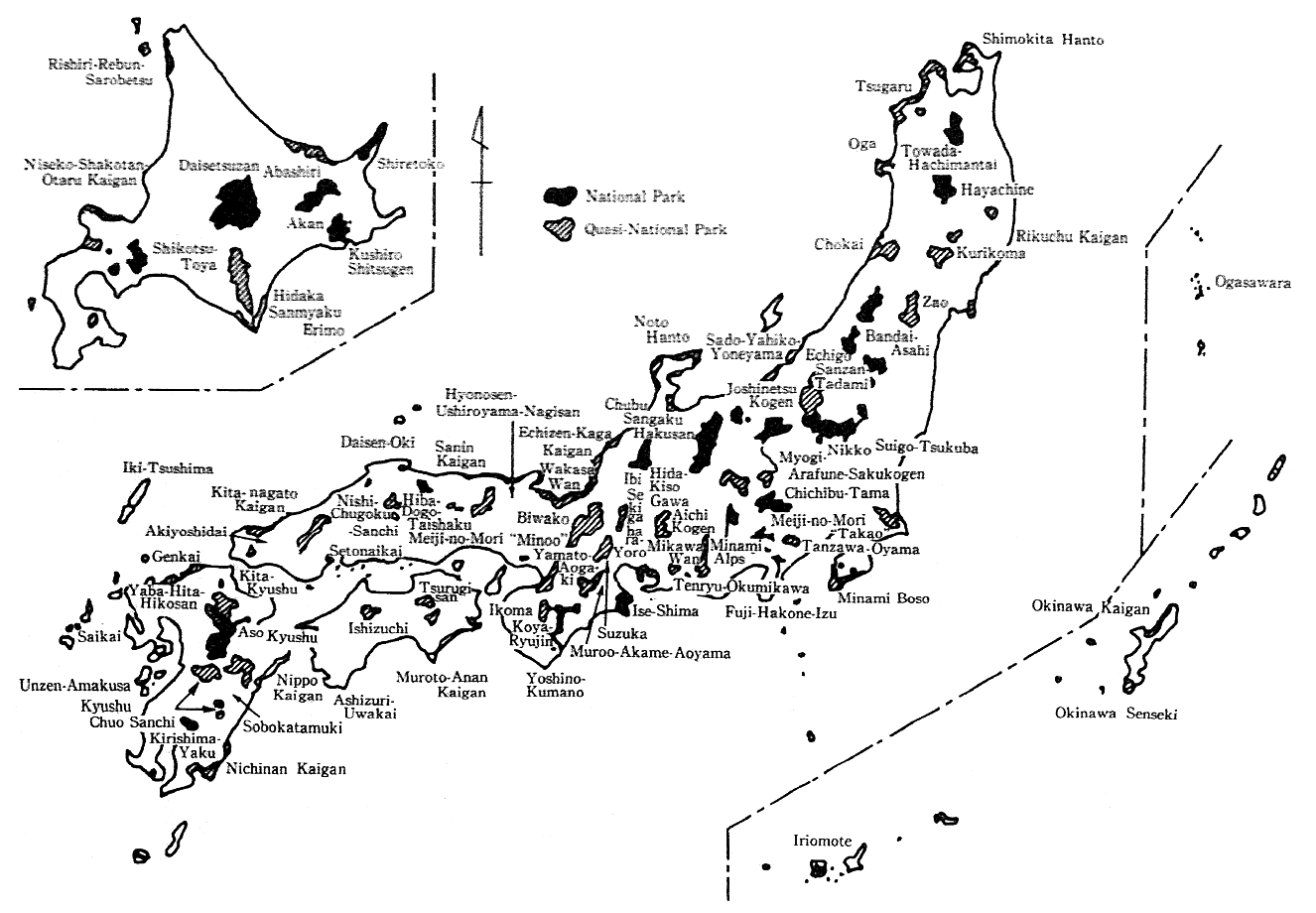
(3) Review of Park Programs
It is stipulated that park programs shall be formulated to work for an appropriate protection and utilization of the natural parks, but to cope with changes in the social and other conditions under which national parks are placed, it has been made a practice to review park programs with priority given to a strengthening of the protection of nature since fiscal 1973. As regards parks whose review is completed, it is made a practice to check park programs almost every 5 years.
In fiscal 1989, the review of the Seto Inland Sea National Park (Okayama Prefecture) and the Unzen-Amagusa National Park (the Amagusa area) was completed, and the Daisen-Hoki National Park and the Fuji-Hakone-Izu National Park (the Hakone area and the Izu Peninsula) were inspected.
In respect of programs for quasi-national parks, reviews are made by the State and prefectures in the same manner as are done for national parks. In fiscal 1989, the review of the Hida-Kiso River Quasi-National Park (Gifu Prefecture) and the Ibi-Sekigahara-Yoro Quasi-National Park and the Genkai Quasi-National Park (Fukuoka Prefec-ture) was completed.
As park programs of prefectural natural parks are often not formulated, guidance was provided to encourage the formulation.
2. Protection of Nature in Natural Parks
(1) Protection of Scenic Spots in Natural Parks
a. Restrictions on Acts in Natural Parks
In the natural parks, "special areas," "special protection areas" and "submarine-park areas" are designated to protect scenic spots (Table 10-2-2). For the evolution of a variety of activity in those areas, it is necessary to get permission from the Director-General of the Environment Agency. In this instance, efforts are made for the appropri-ate protection of scenic spots with the invocation of the Guideline for the Screening of Various Acts in National Parks (excluding the ordi-nary areas). The number of applications filed with the Director-General of the Environment Agency for various acts in the "special areas" and the "special protection areas" of national parks is shown in Table 10-2-3.Even in the ordinary areas, there is the need to file a report with the prefectural governor when it comes to certain acts.
Table 10-2-2 Classified Areas in Natural Parks

Remarks: Surveyed by the Environment Agency The national land area 37,771,961 hectares (as of October 1988 by National Land Institute.)
Table 10-2-3 Application for Permission of Activities in Natural Parks

Notes: 1. Surveyed by the Environment Agency.
2. "Others" changes in land configuration.
3. Figures in parentheses are in the special protection areas.
4. Number include deliberation by organization of national government.
b. Studies and Surveys on Methods to Control Scenic Spots
In order to work for the protection and control of areas with invaluable nature which constitutes the core of scenery in natural parks, the causative factors for changes in locally unique ecosystems are clarified and surveyed to establish protection and control methods. In fiscal 1989, a survey on measures for the environmental protection of spawning grounds for marine turtles in the Iriomote National Park was carried out.
(2) Measures for Environment Conservation in Natural Parks
a. Projects for Beautification and Cleaning
The trash thrown away by the users of natural parks not only impairs the scenery but gives rise to environmental pollution, such as the generation of offensive odor in many instances. In order to positively promote the beautification and cleaning of major areas in the national parks the users of which are many, projects for th upbringing and strengthening of organizations for beautification and cleaning and for the subsidization of cleaning done by those organization are conducted.
The first Sunday of August is designated as the Natural Park Cleaning Day, and the beautification and cleaning of natural parks across the country were done with the cooperation of related prefec-tures that day.
b. Projects for Conservation of Special Plants, Etc.
In order to comprehensively implement measure for the protec-tion of those precious plants in national parks which has to be protected with due consideration given to their growth environment, grants-in-aid were given to related local governments to cover the costs required for the revival of vegetation; surveys on the environment, etc.; and the extermination of blight and so forth at places, such for the Oze Marshland.
c, Extermination of Demon Asteroids
In order to conserve the scenery of coral reefs in the submarine parks of the Iriomote National Park, Amami Island Group Quasi-National Park and other parks, where demon asteroids (Acanthaster panei) extraordinarily proliferated grants-in-aid were given to the related local governments to cover the costs for the extermination of demon asteroids.
d. Rationalization of Use of Automobiles
As vegetation was damaged and the pleasant and safe utilization of parks was impaired due to increased trips by automobiles into those areas in natural parks whose natural environment was prominent, the traffic controls based on the Road Traffic Law and other measures, such as the operation of buses in lieu of privately-owned cars, were conducted under the Operating Procedure for Rationalization of the Use of Automobiles in National Parks (formulated by the Environment Agency in March 1974).
e. Conservation of Areas With Specified Natural Environment
To work for the appropriate protection of precious ecosystems in national parks, experiments and surveys were conducted on measures to conserve forests of "touhi" (Picea jezoensis) in the Yoshino-Kumano National Park and the Sarobetsu Wild Plains in the Rishiri-Rebun-Sarobetsu National Park.
f. Measures for Conservation of Lakes and Marshes
In order to conserve lakes and marshes and the water quality of rivers in natural parks, the development of sewer systems and other projects, including those for the development of public sewer systems for conservation of the specified environment, were promoted in the Amagi-Yugashima and other areas of the Fuji-Hakone-Izu National Park.
(3) Strengthening of Custody System
Efforts have been made for years to rationalize the custody of national parks with the establishment of a national-park custodian office in each national park with the cooperation of local governments and private organizations. To cope with changes in the circumstance surrounding national parks in recent years, efforts were made to strengthen the custodian system commensurate with the local character-istics.
a. National-Park Custodian Offices
To protect and control scenic spots in national parks and carry out a broad range of administrative work, such as guidance to people engaged in the management of parks and briefings on nature to park users, national-park custodian offices were established in the Kushiro Marshland, Nikko and 9 other parks and national-park custodians were assigned. In this fiscal year, too, efforts were made to strengthen the control system. As of the end of fiscal 1989, the authorized strength of national park custodians was 113.
In order to assure appropriate controls commensurate with the actual situation of each national park, a control program is formulated. In fiscal 1989, control programs were formulated for 7 parks including the Ise-Shima National Park.
b. Private Organizations' Activities
(a) The Natural Park Beautification and Custodian Foundation carried out projects, such as the beautification and cleaning of parks, the maintenance and custody of park facilities and the dissemination of thoughts about the protection of nature, for 17 areas in the national parks including the Kamikochi area of the Chubu Mountains National Park.
(b) The Fund for Conservation of the Natural Environment for the Honshu-Shikoku Suspension Bridge, a foundation, subsidized projects for beautification and cleaning and for the propagation of thoughts about the conservation of nature and carried out other measures, such as measures for conservation of the natural environment of the Seto Inland Sea National Park around the bride.
3. Purchase of Privately-owned Land for Conservation Of Nature
In order to coordinate the maintenance of scenic spots in national and quasi-national parks and the protection of wild birds and animals in nationally-established bird and animal reserves with the private rights of the owners of private land, purchases by prefectures are subsidized.
The actual purchases made in the last 5 years are shown in Table 10-2-4. Up to now, 5,180.44 hectares of private land in 49 areas have been purchased (with a total project outlay of ¥9,213,643,000).
Table 10-2-4 Purchase of Privately Owned Land with Subsidies, Including Redemptions on Local Grant Bonds
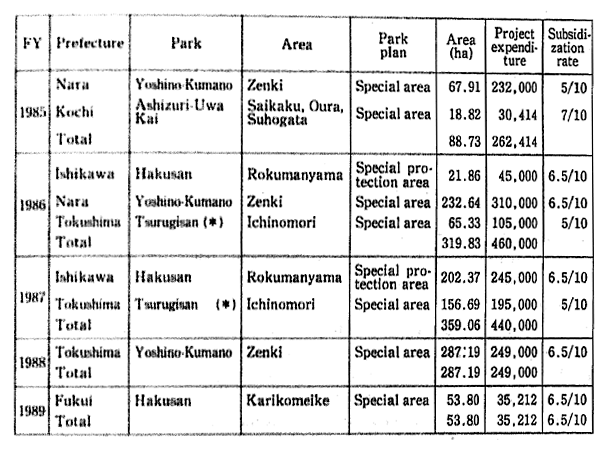
Remarks: 1.surveyed by the Environment Agency.
2. The asterisk represents a quasi-national park. Otherwise, the listed are national parks.
4. Protection and Appropriate Utilization of Natural Parks and Nearby Nature
When it comes to natural parks, there is the need to protect them as areas with scenic spots which represent the nation and work for their sound utilization as core areas for the people's outdoor recreation. From this point of view, the Subcommittee for Studies on Utilization in the Natural Park Group of the Natural Environment Conservation Council came out with a study report in May 1989. As regards the desirable way of utilizing natural parks, it is pointed out in the report that "sustainable utilization" should be made a principle, first, whereby scenic spots, ecosystems and other natural resources may not be affected, and that priority should be given to "irreplaceable utilization" by which it means that utilization can be made only in the given areas.
The report also says that it is necessary to work for the "appro-priate utilization of appropriate places," by which it means assurances that natural parks may function as places for the utilization by the people of natural parks in a diversified manner, and to promote the empirical utilization of natural parks with priority given to software services so that the people may be able to get themselves acquainted with the charms of nature equipped to natural parks. The tangible measures include (1) the adoption of a system of area-type classification in terms of utilization, (2) the establishment of a park management style similar to that of public estate, (3) the development and vitalizing of pivots of utilization, (4) the replenishment and sophistication of facilities and (5) the development of a system for the realization of desirable utilization.
An example which coordination between protection and utiliza-tion is particularly called for is the Oze area in the Nikko National Park. In recent years, there has been a rise in the number of people visiting there due to the development of roads, railways and other means of transport and the availability of increased leisure time, and the conservation of the favorable natural environment has been impaired, as is the case with the production of adverse impacts on marshland plants by human-waste treatment water and miscellaneous effluent from public toilets and other facilities. For this reason, related adminis-trative institutions established a council in September 1988 to study conservation measures. It is decided to develop facilities for the treat-ment of waste water, such as the replacement of public toilets and the development of purification tanks in fiscal 1990.
5. Facilities in Natural Parks
In order to assure the safe and pleasant utilization of national and quasi-national parks with natural scenic spots and prevent the devasta-tion of nature by their utilization, while responding to the people's need to hold communion with nature in the parks, 178 core facilities were developed for their utilization in fiscal 1989 as indicated below.
[1] Conservation of nature--Easing and elimination of excessive utilization, dispersion of utilization, and development of pathways, open squares for picnic sites and public toilets.
[2] Prevention of accidents--Development of pathways and cottages of refuge designed for the assurance of users' safety and the prevention of accidents, redevelopment of outdated facilities.
[3] Education on nature--Development of visitors' centers with exhibits, camping grounds and the like designed to deepen the correct understanding about nature and learn the manner to come in contact with nature.
(1) Facilities in Natural Park
In 1988, an estimated 923 million people utilized natural parks, up about 160 million from 10 years before. In order to respond to the people's such desire to come in communion with nature, there is the need to conserve diversified natural environments and step up their utiliza-tion commensurate with the quality of nature.
For this purpose, various key facilities for the utilization of natural parks, such as natural pathways and camping grounds are being developed, depending on the quality of nature. A systematic illustration is given in Table 10-2-5.
Fig. 10-2-5 System for Provision of Natural Parks
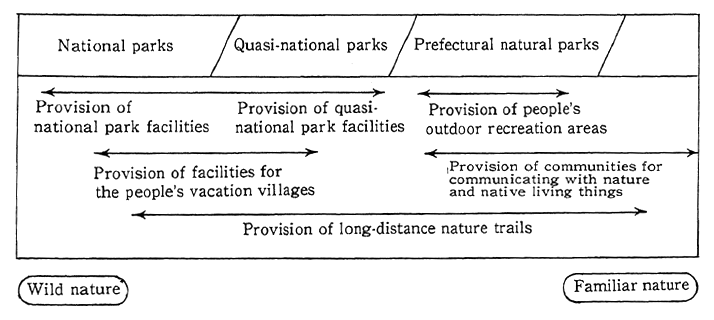
a. Facilities for Utilization of National and Quasi-National Parks
As there are areas whose natural environment are excellent in national and quasi-national parks, open squares for picnic and other sites, pathways, camping grounds and other facilities were developed to respond to the people's desire to hold communion with nature and promote their safe and pleasant utilization, while giving consideration to their natural environment. Incidentally, the development of utiliza-tion facilities in national and quasi-national parks is indicated in Table 10-2-6.
b. National Vacation Villages
The system of national vacation villages is so designed that a wide variety of facilities to make it possible to hold communion with nature, let alone sound lodging facilities usable at low fares in areas suitable for rest with an excellent natural environment in national and quasi-national parks. At present, 30 such areas are in use.
Of all facilities for national vacation villages, open squares for picnic, pathways, camping grounds and other facilities are developed by the State or local governments, whereas billets, lodges, ski lifts and other toll facilities are developed and managed by the National Vacation Village Association, a foundation.
Trends in the number of people using national vacation villages by year are given in Table 10-2-7.
Table 10-2-6 Provision of National and Quasi-national Parks in FY 1989
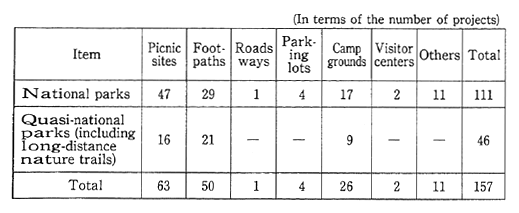
Remarks: Surveyed by the Environment Agency.
Table 10-2-7 Trends in Number of Users of the People's Vacation Villages
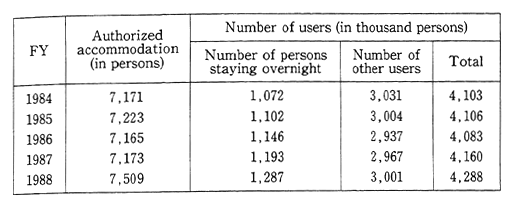
Remarks: Surveyed by the Environment Agency.
c. People's Outdoor Recreation Areas in Prefectural Natural Parks
The people's outdoor recreations areas in prefectural natural parks are areas which are developed with priority given to enabling suburban visitors to come in deeper communion with nature through their activities to positively work on nature and to get themselves acquainted with the harmony between nature and man. Facilities for the display of exhibits (community natural park centers), open squares for picnic and other sites, camping grounds and other facilities are to be developed in 5 years. In fiscal 1989, the development of 7 facilities which had been carried over from the previous fiscal year was done.
d. Long-Distance Nature Trails
Long-distance nature trails are designed to encourage the people to get refreshed both in mind and body with visits to nature and historic remains on foot and deepen their understanding about the conservation of nature. They have been developed since fiscal 1970 as nature trails, long in distance, organically linking natural parks and cultural assets. They are developed, while seeing to it that they are usable throughout the year and readily accessible urbanites, and they measure 8,630 kilometers in aggregate length. In fiscal 1989, the development of the Shikoku Nature Trail was completed.
In 1988, 17,250,000 people used long-distance nature trails. They are outline in Table 10-2-8.
Table 10-2-8 Outline of Long-Distance Nature Trails
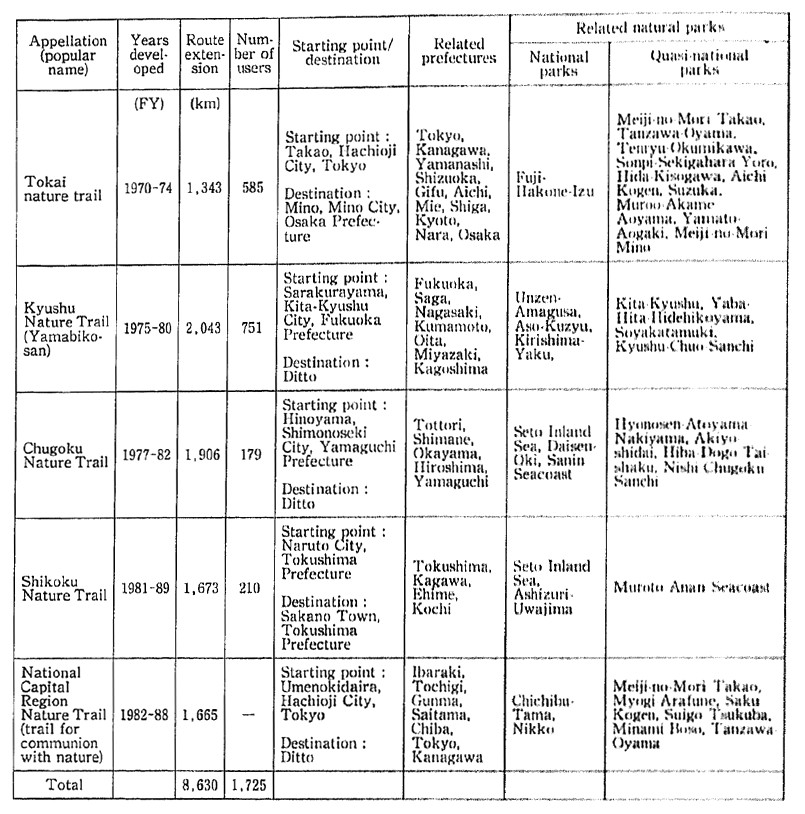
6. Guidance to Users of Natural Parks
With the availability of increased leisure time and the evolution of urbanization in recent years, the desire to come in communion with nature is on the rise. In response to this social need, it has become important to promote the appropriate utilization of the natural environ-ment, such as with the maintenance and creation of places of commu-nion with nature and the offer of appropriate information. In particular, it is quite significant to assure opportunities to come in contact with nature in terms of a deeper understanding about nature for children who will conserve and foster nature in the future.
The following measures were implemented in fiscal 1989 to contribute to the proper utilization of natural parks.
[1] For the appropriate utilization of natural parks, guidance was provided on the utilization by 2,000 volunteers, including guidance officials on natural parks.
[2] With the cooperation of each prefecture and the National Park Association, a foundation, a campaign for familiarization with nature was made at national parks, quasi-national parks and prefectural natural parks for one month from July 21 to August 20 for the promo-tion of mental and physical health and for an enhancement of the spirit of conserving nature and making more beautify the national land through familiarization with nature. The central event was the 31st Natural Park Convention held at the Shigashima National Vacation Village in the Genkai Quasi-National Park (FukuokaPrefecture).
[3] In the core and other areas for the utilization of national parks, on-the-spot guidance on outdoor activities and briefings on nature were given by guidance officials on outdoor activities to step up the dissemi-nation and enhancement of thoughts about the conservation of nature and the appropriate utilization of the natural environment.
[4] In order to deepen the people's contact with nature while ram-bling around in the natural environment, enhance the spirit of conserv-ing nature and promote mental and physical health, the 8th Convention for the Nation to Join in Rambling Along Nature Trails was held in October with the cooperation of each prefecture and the Japan Associa-tion for Walk and Walk and other private organizations. An estimated 60,000 people walked along nature trails in 44 prefectures across the country.
III. Conservation of Wildlife
Wildlife is one of the important components of the natural envi-ronment and is indispensable for human beings from the standpoint of science, economics and recreation. In addition, importance is attached to wildlife as a potentially usable "storehouse" of genes in medicine, agriculture, forestry and other sectors as genetic engineering has made progress in recent years. The wide variety in value inherent in wildlife is broadly recognized today. There is an increasing strong demand for the protection of wildlife both at home and abroad.
In order to satisfy such demand for wildlife protection in recent years, and further to promote wildlife protection activities, the Environ-ment Agency is undertaking the following measures to further enrich the wildlife protection policy.
(1) The Sixth Wildlife Protection Project Plan
Based on the Sixth Wildlife Protection Plan (for fiscal 1987-91), each prefectural government took measures for the protection of wildlife, such as surveys on the living condition of wildlife, the establish-ment of wildlife protection areas and so on.
(2) Wildlife Protection Areas
The Director-General of the Environment Agency as well as prefectural governors establish wildlife protection areas and designate special wildlife protection areas for the protection and propagation of wildlife.
In the establishment of national wildlife protection areas, priority is given to areas where protection of wildlife is of particular importance from a national point of view. In fiscal 1989, the ma Wildlife Protection Area (Nagasaki Prefecture) and the Tsurugi Mountain, Wildlife Protec-tion Area (Tokushima and Kochi prefectures) were established.
The wildlife protection areas established as of the end of fiscal 1988 is shown in Table 10-3-1.
Table 10-3-1 Present State of Wildlife Protection Area
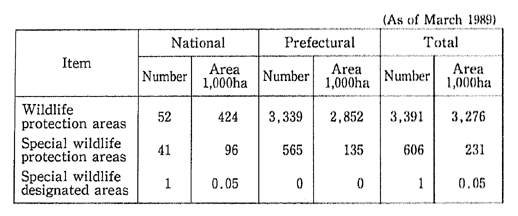
Remarks: Surveyed by the Environment Agency.
(3) Protection of Endangered Species
The survey on threatened fauna and flora, which had been con-ducted to collect basic data on the protection of threatened taxa, were tabulated, and the following measures were taken to step up protection and propagation.
a. Regarding Japanese Crested Ibise (Nipponia nippon), an artificial propagation project had been carried out with 2 males and 1 female, including 1 male Japanese Crested Ibis borrowed from China in fiscal 1985, but in fiscal 1988, the 1 borrowed male from China was returned on November 7 and 1 male born in Japan was moved to the Beijing Zoo on March 5,1990, in order to promote the propagation project between Japan and China.
b. For Iriomote Wild Cats (Mayailus iriomotensis), feeding was done as a part of their protection and propagation project.
c. For Japanese Crane (Grus japonensis), feeding is done in the winter season with the assignment of watchmen. It was confirmed that 441 Japanese Cranes inhabited the nation.
d. For Blakiston's Fish-Owl (Ketupa blakistoni), nest boxes were installed and feeding was done.
e. Special birds, such as golden mountain thrush, Riukiu robin and so on were surveyed on their living conditions.
f. On Golden Eagles, Mountain Hawk Eagles, Northern Goshawks, Asiatic Black Bears and Brown Bears, basic studies were performed for an ecological clarification of their behavior and dietary patterns.
g. For Japanese Monkey in the Shimokita Peninsula and Hazel Grous, protective measures, such as surveillance and the conservation of their habitat, were taken.
h. For Japanese Rose Bitterling (freshwater fish) and Hokuriku Salamanders, projects for their conservation and propagation were performed.
i. In the Nansei Islands where many precious species, such as Okinawa Rails, Cheirotonus Jambar live, surveys were conducted on their distribution and living condition.
j. Surveys were conducted on the selection of habitats important for wildlife.
k. For Tsushima Wild Cats, feeding and other projects were started as part of their protection and propagation in fiscal 1989.
l. A survey was conducted on measures to conserve the nesting grounds of short-tailed Albatrosses on Torishima Island, where the environment had been deteriorated due to the inflow of mud and sand.
(4) Promotion of Measures for Protection of Japanese Serows (Capricornis crispus) and Prevention of Damage
With regard to Japanese serows, a wide variety of measure is taken for their protection and the prevention of damage caused by them in accordance with the policy decided by the consultation among the Agency for Culture Affairs, the Forestry Agency and the Environment Agency.
a. In fiscal 1989, a reserve for Japanese serows was established in Mt. Kii.
b. Particularly in areas where severe damage had been caused, preventive measures, such as the installation of protective fences and poly-nets, were taken. The number of Japanese Serows was adjusted in Gifu, Nagano and Aichi prefectures.
c. Trends in the living condition of Japanese Serows were surveyed and the appropriate measures for conserving and controlling Japanese serows were studied.
(5) Implementation of Boarding Surveys on Migratory Birds
Major staying and wintering places for migratory birds were selected as observation stations. Ten important places were selected as Class I observation stations and 50 other places were selected as Class II observation points. Boarding surveys on the migratory birds were implemented at these stations.
(6) Rationalization of Hunting
Hunting, as long as it is appropriately controlled, plays an extremely important role as a means to regulate the number of birds and animals alive to the carrying capacity of nature.
a. Designation of Hunting Areas
The hunting areas are areas where hunting may be done while attempts are positively made to work for the protection and propaga-tion of games on one side and regulated and orderly hunting may be done with restrictions imposed on the number of hunters, the days of hunting and on the species and number of hunted birds and mammals, on the other.
As of the end of fiscal 1989, 62 places were authorized as hunting areas. (Table 10-3-2).
Table 10-3-2 Establishment of Hunting Areas
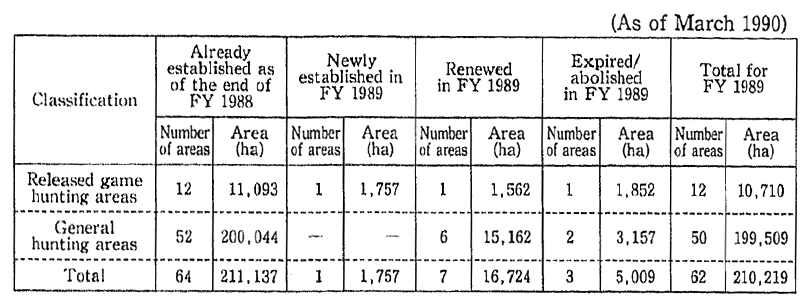
b. Prevention of Illegal Capturing
In order to prevent the illegal capturing of thrushes and other birds with mist nets and that of raptors, the Environment Agency, Ministry of International Trade and Industry, National Police Agency and Forestry Agency joined in strengthening controls and promoting dissemination and enhancement, and guidance was provided to prefec-tures and some NGOs for the promotion.
(7) Control of Birds Reared
In order to appropriately control birds reared with permission, the conventional styles of rearing licenses was revised, and the rings fitted to their feet were defined as part of rearing licenses.
(8) International Cooperation in Protection of Wildlife
As for the Convention on International Trade in Endangered Species of Wild Fauna and Flora (CITES or Washington Convention), the implementation of this convention was strengthened, as such by the withdrawal of specific reservations held on musk deer (Moschus spp.) and saltwater crocodiles (Crocodylus porosus).
At the seventh Meeting of the Conference of the Parties to CITES held in Lausanne, Switzerland, the amendments of Appendices to the convention were made among which was transfer of African elephant from Appendix II to I. The Conference of the Parties also decided the next meeting to be held in Japan in the spring of 1992.
With regard to the Convention on Wetlands of International Importance Especially as Waterfowl Habitat (the Ramsar Convention), Lake Kutcharo was designated as a new Ramsar site in June 1989, and the area of the Kushiro Marshland as a Ramsar site was expanded.
With respect to the bilateral cooperation, information was ex-changed at the Fifth Australia-Japan Conference on the Protection of Migratory Birds (in Tokyo in June 1989) and the First Soviet-Japan Study Meeting on the Protection of Migratory Birds (in Moscow in September 1989) in accordance with the conventions and agreement for the protection of migratory birds and in danger of extinction and their environment between the United States and Japan, between Australia and Japan, between China and Japan and between the Soviet Union and Japan.
The Japan International Cooperation Agency (JICA) offered technical cooperation in stepping up the protection and propagation of wild Japanese crested ibis in China.
In order to contribute to the protection of birds in developing countries, a project for cooperation with member countries of the Association of South East Asian Nations (ASEAN) (for fiscal 1989-1994) has launched.